Link to Idaho State Brand Inspector // Idaho Brand Request Form: AppforRecordingBrand
Cody.Burlile@isp.idaho.gov To Schedule a Brand Inspection Call: 208 459-4231 (Caldwell Office)
Link to Idaho State Brand Inspector // Idaho Brand Request Form: AppforRecordingBrand
Cody.Burlile@isp.idaho.gov To Schedule a Brand Inspection Call: 208 459-4231 (Caldwell Office)
May 2, 2018
Thanks for the opportunity to share our latest proposed veg management project on the Emmett RD of the Boise NF.
As mentioned in our presentation – I am looking for candidates who are interested in becoming a member of the SW ID RAC. This is the group that makes recommendations on how Title II Secure Rural School monies are distributed.
If interested, please complete the attached form and either email it back to me or send it to me at: Richard Newton, 1805 Highway 16, Emmett, ID 83617.
Please call if you have any questions.
Thanks again.
RN.
Richard E. Newton
District Ranger
P: 208-365-7001
C: 208-994-1268
renewton@fs.fed.us
USDA Forest Service
Emmett Ranger District
1805 Highway 16, Room 5
Emmett, ID 83617
Form to Fill Out: AD-755_FORM_southwest_idaho_rac
On April 28, 2018 the “Git R Done” team of Janine Townsend, Janelle Weeks, Shelly Duff and Kelly Ragland, lead by Lisa Griffith planned and executed one of the best clinics that Squaw Butte has ever hosted. They arranged for guest Speakers farrier Joe Prince and Vet Daniel Dombroski to do presentation. They arranged for a Hot Dog truck to be on site for Lunch and they spent hours working on presentations for a woman centrist packing clinic. They divided the clinic up into four segments. 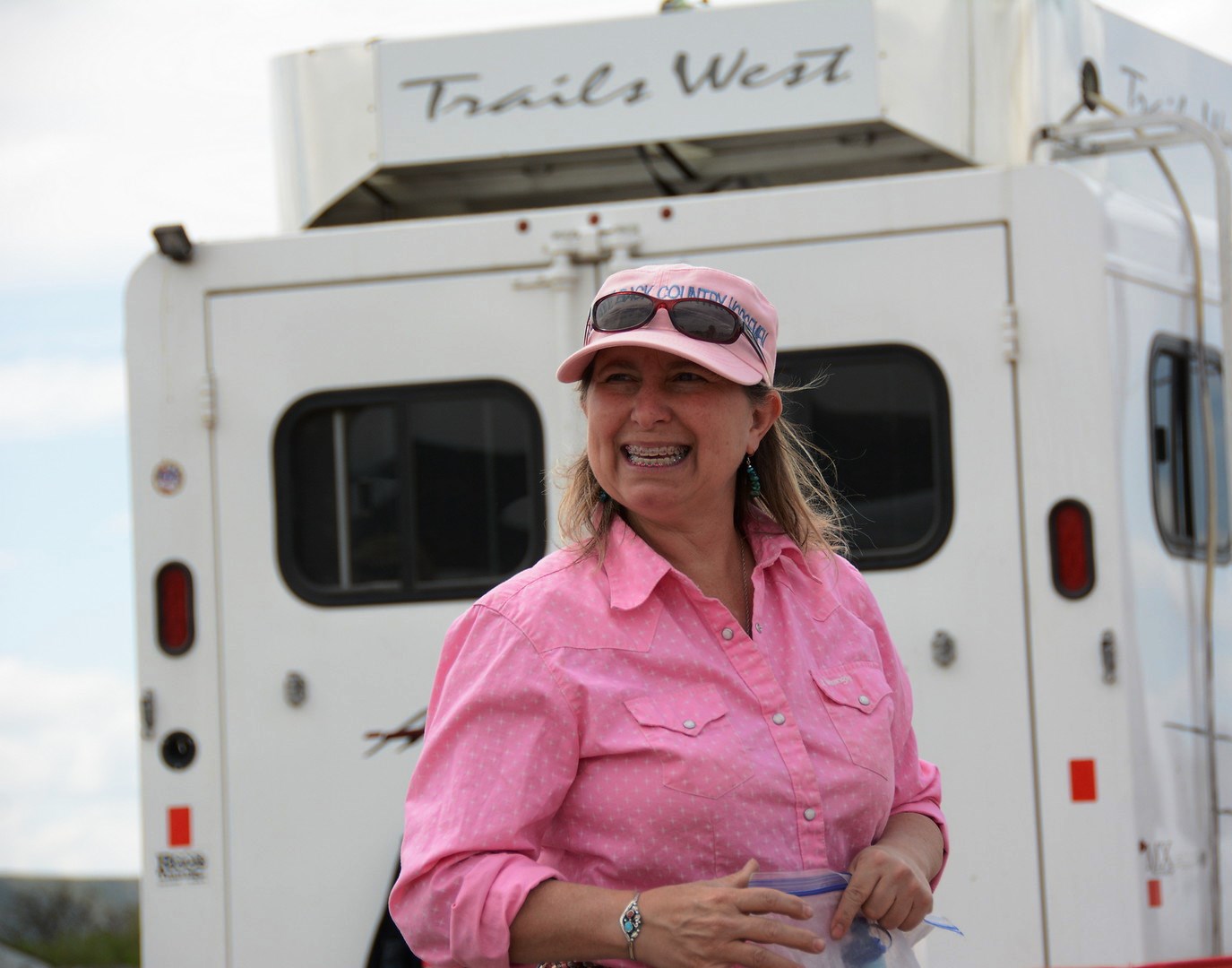
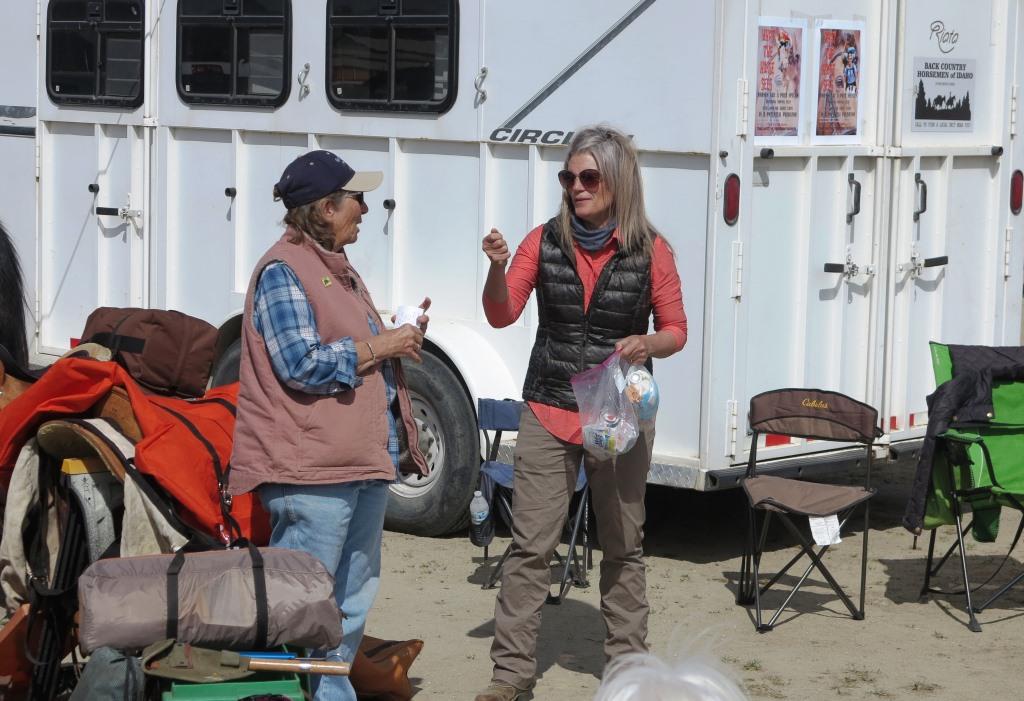 The first was Joe Prince’s presentation on what to do if you loose a shoe in the back country. Participants asked lots of good questions and Lisa horse did a great job modeling her hoofs.
The first was Joe Prince’s presentation on what to do if you loose a shoe in the back country. Participants asked lots of good questions and Lisa horse did a great job modeling her hoofs.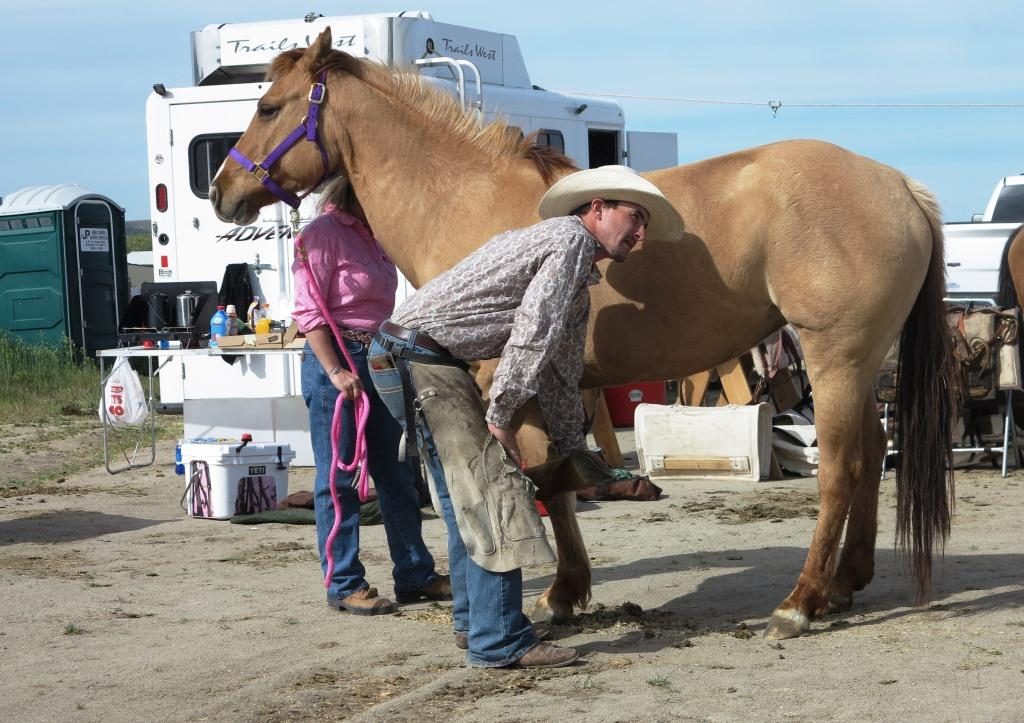 The second segments was lead by Janine Townsend and was a quick but fact filled discussion of packing and tips and techniques. During Janine’s talk the rest of the team demonstrated items she was covering.
The second segments was lead by Janine Townsend and was a quick but fact filled discussion of packing and tips and techniques. During Janine’s talk the rest of the team demonstrated items she was covering.
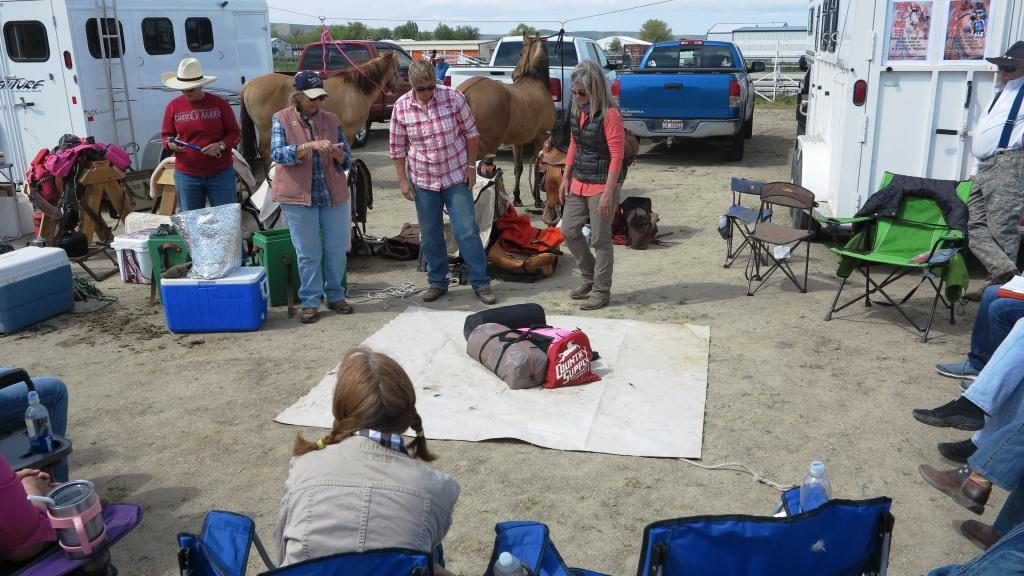

After their presentation, a lunch break allow participants to digest what they had learned and some of the best hot dogs I have had out side of a ball park. After lunch three demonstration stations were set up and Marybeth Conger and Rob Adams assisted the rest of the team doing hands on demonstrations and answering lots of great questions.
Marybeth demonstrates how to manty up a body, a skill luckily, I have never had to practice. Her presentation had every one at her station in stitches.
The final segment of the day was an “On the Trail” question and answer session with Dr. Dan and equine radiologist Dana Neelis. The Vets covered what they think should be in our saddle bags to do on the trail first aid for our stock, what to look for and how to start treatment before we can get them to a vet.
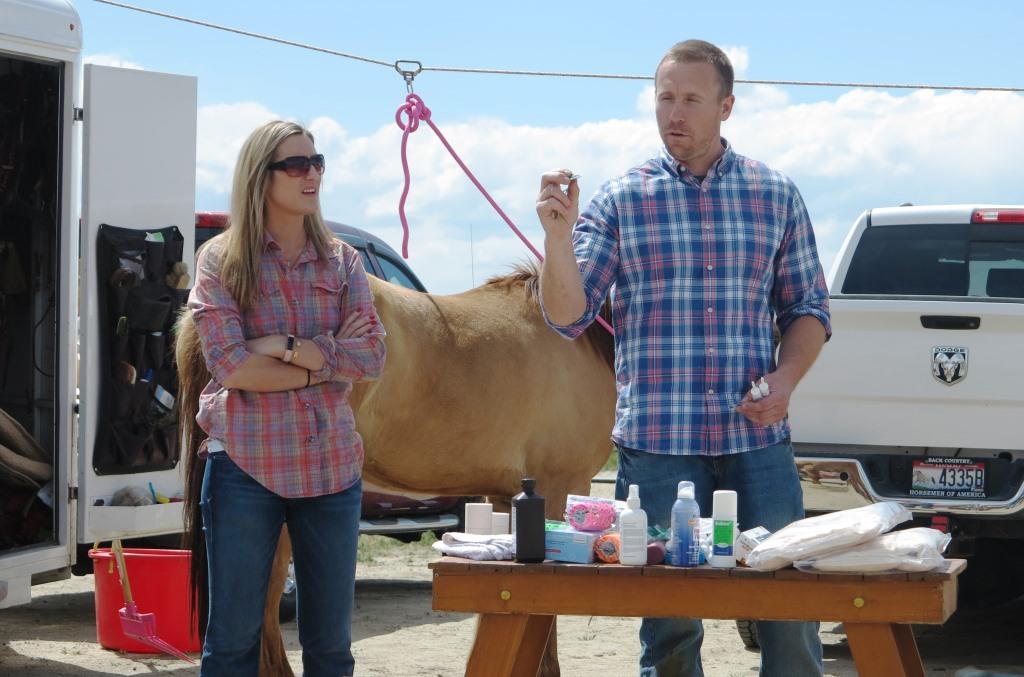 If you attended this clinic you spend a fun and information packed day and left a bit over whelmed but raring to go try some of the things you saw demonstrated or got a chance to try yourself. If you missed this one, hopefully this team of woman will hold another one in the future! More Pictures
If you attended this clinic you spend a fun and information packed day and left a bit over whelmed but raring to go try some of the things you saw demonstrated or got a chance to try yourself. If you missed this one, hopefully this team of woman will hold another one in the future! More Pictures
 On Saturday April 21, 2018 members of Squaw Butte spent a full day with members of the Bogus Basin Ski Patrol lead by chief instructor Karen Alfonso-King in a full day of Wilderness first aid and CPR. While these pictures show us sitting down a watching, most of the day was spend laughing and doing. It is just hard to be applying a splint or doing an assessment at the same time. All who attended the class left with their first aid knowledge expanded and refreshed and more confidence that should the need arise that they would be able to use their first aid skills to render assistance in the back country or in their back yard.
On Saturday April 21, 2018 members of Squaw Butte spent a full day with members of the Bogus Basin Ski Patrol lead by chief instructor Karen Alfonso-King in a full day of Wilderness first aid and CPR. While these pictures show us sitting down a watching, most of the day was spend laughing and doing. It is just hard to be applying a splint or doing an assessment at the same time. All who attended the class left with their first aid knowledge expanded and refreshed and more confidence that should the need arise that they would be able to use their first aid skills to render assistance in the back country or in their back yard.
SAM Splints are one of the simplest and most versatile pieces of first aid equipment available so at least one should be in every outdoor First Aid kit. A soft, malleable aluminium strip sandwiched in foam, the splints become fairly rigid once formed into a 3D shape, the more complex the shape, the more rigid they become.
Using SAM Splits SAM Split Video #1 SAM Splint Video #2 Using SAM splints to Maximun Effect
Detailed description of “STOP the BLEED” Steps
Wilderness First Aid P1 P2 P3 P4 P5 P6 Simulated Accident Kit Evac Helicopter LF1 LF2 NOLS
Medical Emergency Kit P1 P2
Wilderness First Aid (WFA) National Outdoor Leadership – NOLS
The report represents a first-of-its-kind analysis of total annual visitation to U.S. public lands in 11 Western states: Arizona, California, Colorado, Idaho, Montana, Nevada, New Mexico, Oregon, Utah, Washington, and Wyoming. Visitation to all types of public lands and waters administered by the four U.S. land management agencies — National Park Service, Bureau of Land Management, U.S. Fish and Wildlife Service, U.S. Forest Service — were considered in the report.
“We knew public lands are popular, but we were surprised to learn just how deep America’s love for our public lands runs,” said Lucy Livesay, Policy and Communications Manager at the Center for Western Priorities, who led the research. “To put it in context, 290 million visits is equivalent to nearly 90 percent of the entire population of the United States. It’s more than the amount of people who visited zoos and aquariums, watched the Super Bowl, or attended every NFL, NBA and MLB game combined last season. In a country with so many recreation, leisure, and entertainment options, our public lands take a backseat to none.”
According to the report, the popularity of public lands continues to grow. National park visits in the 11 Western states jumped from 81 million in 2006 to more than 108 million in 2017. National monument visits have nearly tripled since 2000.
The popularity of national public lands is a significant factor in their local economic impact, according to the report. A recent study by the Outdoor Industry Association found the outdoor industry contributes $887 billion in consumer spending to the national economy and supports 7.6 million jobs across the country. The positive economic impact of public lands is especially outsized in Western states.
Despite the enormous and growing popularity of U.S. public lands across the West, they are being funded and protected less by President Trump and his administration.
According to the analysis, funding for all federal land management agencies as a percentage of the annual discretionary budget has declined since 2000. President Trump’s 2019 budget proposes a 16 percent cut to the U.S. Department of Interior. At the same time the Trump administration has undertaken an unprecedented attack on public lands by eliminating more than 2 million acres of national monuments in southern Utah, an action facing multiple legal challenges.
“The way we fund and protect our public lands should reflect the high regard Americans hold them in and the value they return to our local economies and way of life in the West,” said Jennifer Rokala, Executive Director at the Center for Western Priorities. “That’s not the case today under the Trump administration and this report shows 290 million reasons why our policies and priorities need to change.”
 Subject: Forest Service Announces 15 Trail Priority Areas
Subject: Forest Service Announces 15 Trail Priority Areas
Did you know the Forest Service has designated 15 Trail Priority Areas as required under the National Forest System Trail Stewardship Act of 2016? You can read the announcement below. These trail priority areas should receive additional agency focus and be learning laboratories for involving partners and volunteers in trail maintenance. You can learn more about the National Forest Trails Stewardship Act on our website by clicking this link.
NWSA will help stewardship groups meet this challenge through our National Forest Trails Stewardship Funding. Check out the Trail Funding application and other program information on our website at http://www.wildernessalliance.org/trail_funding. Here you will find the application materials, Fact Sheets, and other information to help your organization put a project proposal together.
USDA Secretary announces infrastructure improvements for forest system trails Focused work will help agency reduce a maintenance backlog and make trails safer for users.
WASHINGTON, FEB 16, 2018 – U.S. Secretary of Agriculture Sonny Perdue today announced the selection of 15 priority areas to help address the more than $300 million trail maintenance backlog on national forests and grasslands.
Focused trail work in these areas, bolstered by partners and volunteers, is expected to help address needed infrastructure work so that trails managed by USDA Forest Service can be accessed and safely enjoyed by a wide variety of trails enthusiasts. About 25 percent of agency trails fit those standards while the condition of other trails lag behind.
“Our nation’s trails are a vital part of the American landscape and rural economies, and these priority areas are a major first step in USDA’s on-the-ground responsibility to make trails better and safer,” Secretary Perdue said. “The trail maintenance backlog was years in the making with a combination of factors contributing to the problem, including an outdated funding mechanism that routinely borrows money from programs, such as trails, to combat ongoing wildfires.
“This borrowing from within the agency interferes with other vital work, including ensuring that our more than 158,000 miles of well-loved trails provide access to public lands, do not harm natural resources, and, most importantly, provide safe passage for our users.”
This year the nation celebrates the 50th anniversary of the National Trails Systems Act which established America’s system of national scenic, historic, and recreation trails. A year focused on trails presents a pivotal opportunity for the Forest Service and partners to lead a shift toward a system of sustainable trails that are maintained through even broader shared stewardship.
The priority areas focus on trails that meet the requirements of the National Forest System Trails Stewardship Act of 2016, which calls for the designation of up to 15 high priority areas where a lack of maintenance has led to reduced access to public land; increased risk of harm to natural resources; public safety hazards; impassable trails; or increased future trail maintenance costs. The act also requires the Forest Service to “significantly increase the role of volunteers and partners in trail maintenance” and to aim to double trail maintenance accomplished by volunteers and partners.
Shared stewardship to achieve on-the-ground results has long been core to Forest Service’s approach to trail maintenance, as demonstrated by partner groups such as the Pacific Crest Trail Association and the Appalachian Trail Conservancy.
“Our communities, volunteers and partners know that trails play an important role in the health of local economies and of millions of people nationwide, which means the enormity of our trail maintenance backlog must be adequately addressed now,” said USDA Forest Service Chief Tony Tooke. “The agency has a commitment to be a good neighbor, recognizing that people and communities rely on these trails to connect with each other and with nature.”
Each year, more than 84 million people get outside to explore, exercise and play on trails across national forests and grasslands and visits to these places help to generate 143,000 jobs annually through the recreation economy and more than $9 million in visitor spending.
The 15 national trail maintenance priority areas encompass large areas of land and each have committed partners to help get the work accomplished. The areas are:
Bob Marshall Wilderness Complex and Adjacent Lands, Montana: The area includes the Bob Marshall, Scapegoat, and Great Bear Wilderness Areas and most of the Hungry Horse, Glacier View, and Swan Lake Ranger Districts on the Flathead National Forest in northwest Montana on both sides of the Continental Divide. There are more than 3,200 miles of trails within the area, including about 1,700 wilderness miles.
Methow Valley Ranger District, Okanogan-Wenatchee National Forest, Washington: Methow Valley is a rural recreation-based community surrounded by more than 1.3 million acres of managed by the Forest Service. The area includes trails through the Pasayten and Lake Chelan-Sawtooth Wilderness Areas and more than 130 miles of National Pacific Crest and Pacific Northwest National Scenic Trails.
Hells Canyon National Recreation Area and Eagle Cap Wilderness, Idaho and Oregon: This area includes more than 1,200 miles of trail and the deepest river canyon in North America as well as the remote alpine terrain of the Seven Devil’s mountain range. The area also has 350,000 acres in the Eagle Cap Wilderness, the largest in Oregon.
Central Idaho Wilderness Complex, Idaho and Montana: The area includes about 9,600 miles of trails through the Frank Church River of No Return; Gospel Hump; most of the Selway-Bitterroot Wilderness areas; portions of the Payette, Salmon-Challis, Nez Perce and Clearwater national forests; and most of the surrounding lands. The trails inside and outside of wilderness form a network of routes that give access into some of the most remote country in the Lower 48.
Continental Divide National Scenic Trail, Montana, Idaho, Wyoming, Colorado and New Mexico: The trail’s 3,100 continuous miles follows the spine of the Rocky Mountains from Mexico to Canada, including more than 1,900 miles of trails across 20 national forests. The trail runs a diverse route with some sections in designated wilderness areas and others running through towns, providing those communities with the opportunity to boost the local economy with tourism dollars.
Wyoming Forest Gateway Communities: Nearly 1,000 miles of trail stretch across the almost 10 million acres of agency-managed lands in Wyoming, which include six national forests and one national grassland. The contribution to the state’s outdoor recreation economy is therefore extremely important in the state.
Northern California Wilderness, Marble Mountain and Trinity Alps: There are more than 700 miles of trails through these wilderness areas, which are characterized by very steep mountain terrain in fire-dependent ecosystems that are subject to heavy winter rainfall and/or snow. As such, they are subject to threat from flooding, washout, landslide and other erosion type events which, combined with wildfires, wash out trails and obstruct passage.
Angeles National Forest, California: The area, which includes nearly 1,000 miles of trails, is immediately adjacent to the greater Los Angeles area where 15 million people livewithin 90 minutes and more than 3 million visit. Many of those visitors are young people from disadvantaged communities without local parks.
Greater Prescott Trail System, Arizona: This 300-mile system of trails is a demonstration of work between the Forest Service and multiple partners. The system is integrated with all public lands at the federal, state and local level to generate a community-based trail system.
Sedona Red Rock Ranger District Trail System, Coconino National Forest, Arizona: About 400 miles of trail provide a wide diversity of experiences with year-round trail opportunities, including world-class mountain biking in cooler months and streamside hiking in the heat of the summer.
Colorado Fourteeners: Each year, hundreds of thousands of hikers trek along over 200 miles of trail to access Colorado’s mountains that are higher than 14,000 feet. The Forest Service manages 48 of the 54 fourteeners, as they are commonly called.
Superior National Forest, Minnesota: The more than 2,300 miles of trail on this forest have faced many catastrophic events, including large fires and a major wind storm downed millions of trees in the Boundary Waters Canoe Area Wilderness in 1999. A similar storm in 2016 reached winds up to 85 mph and toppled trees on several thousand acres and made the western 13 miles of Kekekabic Trail impassible.
White Mountain National Forest Partner Complex, Maine and New Hampshire: Approximately 600 miles of non-motorized trails are maintained by partners. Another 600 miles of motorized snowmobile trails are adopted and maintained by several clubs. Much of that work centers on providing safe public access to the mountain and valleys of New Hampshire and Maine.
Southern Appalachians Capacity Enhancement Model, Alabama, Georgia, Tennessee, North Carolina, South Carolina and Virginia: The more than 6,300 miles of trails in this sub region include some of the most heavily used trails in the country yet only 28 percent meet or exceed agency standards. The work required to bring these trails to standard will require every tool available from partner and volunteer skills to contracts with professional trail builders.
Iditarod National Historic Trail Southern Trek, Alaska: In southcentral Alaska, the Southern Trek is in close proximity to more than half the state’s population and connects with one of the most heavily traveled highways in the state. The Chugach National Forest and partners are restoring and developing more than 180 miles of the trail system, connecting the communities of Seward, Moose Pass, Whittier, and Girdwood.
For more information about the USDA Forest Service visit http://www.fs.fed.us/.
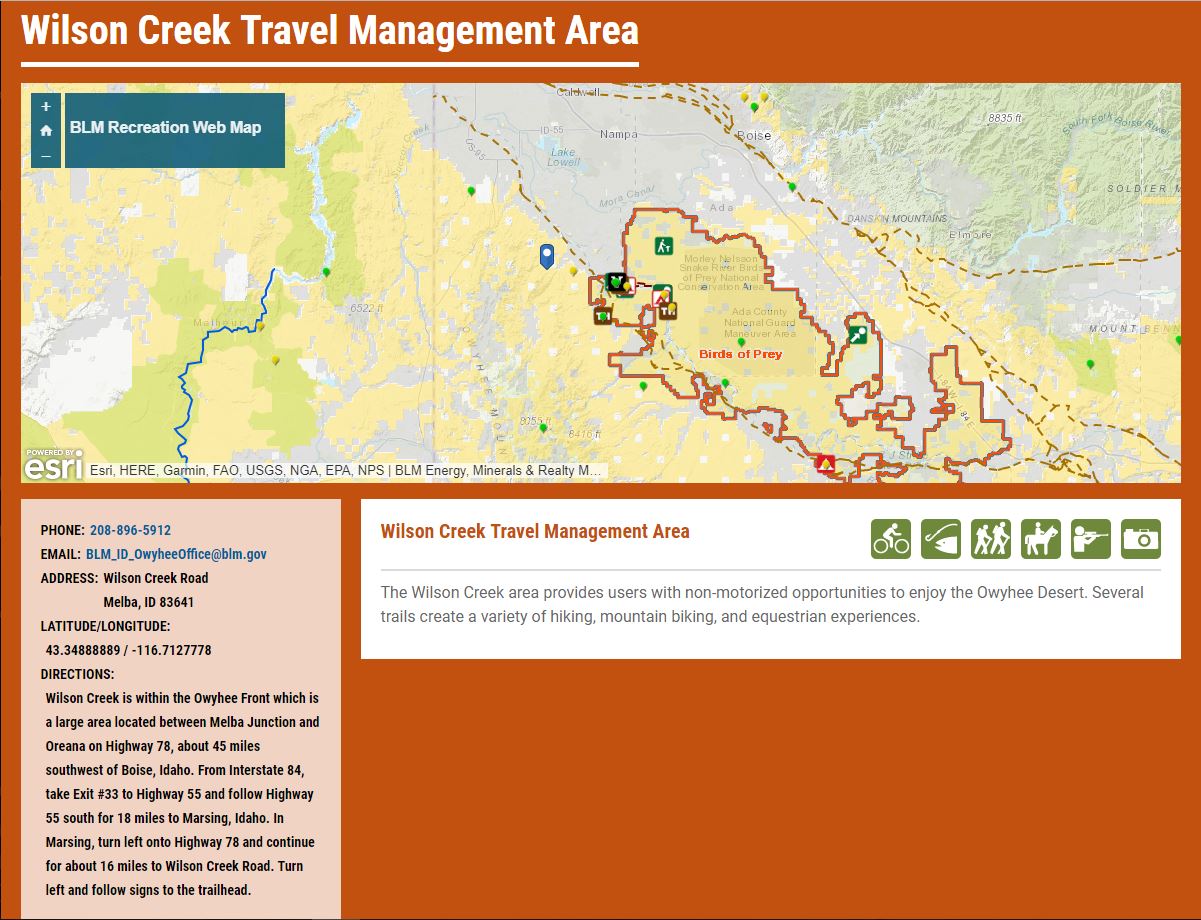 On March 18, 2018 eighteen members and guest of Squaw Butte met at the BLM parking lot of the Wilson Creek Trail head. The area had been in a winter storm warning only 48 hours before but the forecast hinted at a few hours of blue skies and light breezes.
On March 18, 2018 eighteen members and guest of Squaw Butte met at the BLM parking lot of the Wilson Creek Trail head. The area had been in a winter storm warning only 48 hours before but the forecast hinted at a few hours of blue skies and light breezes.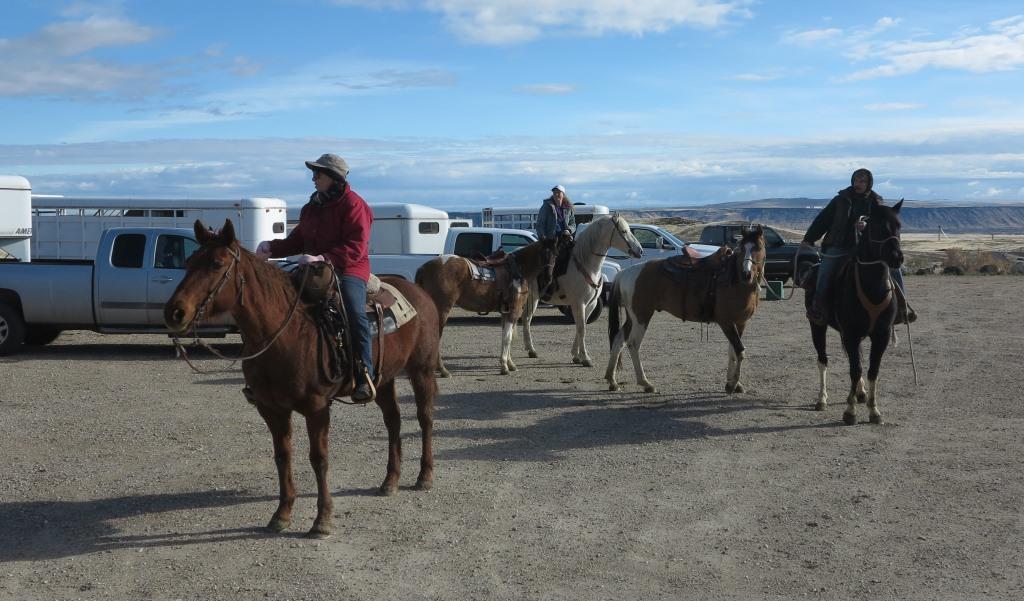 It didn’t take long for stock to be saddled and warm hats to be found and the first of three group started up the trail. A loop was planned that went up the Wilson creek trail, then turned east and crossed the road and worked its way back to the trail head following a series of gullies and 4-wheeler roads.
It didn’t take long for stock to be saddled and warm hats to be found and the first of three group started up the trail. A loop was planned that went up the Wilson creek trail, then turned east and crossed the road and worked its way back to the trail head following a series of gullies and 4-wheeler roads.
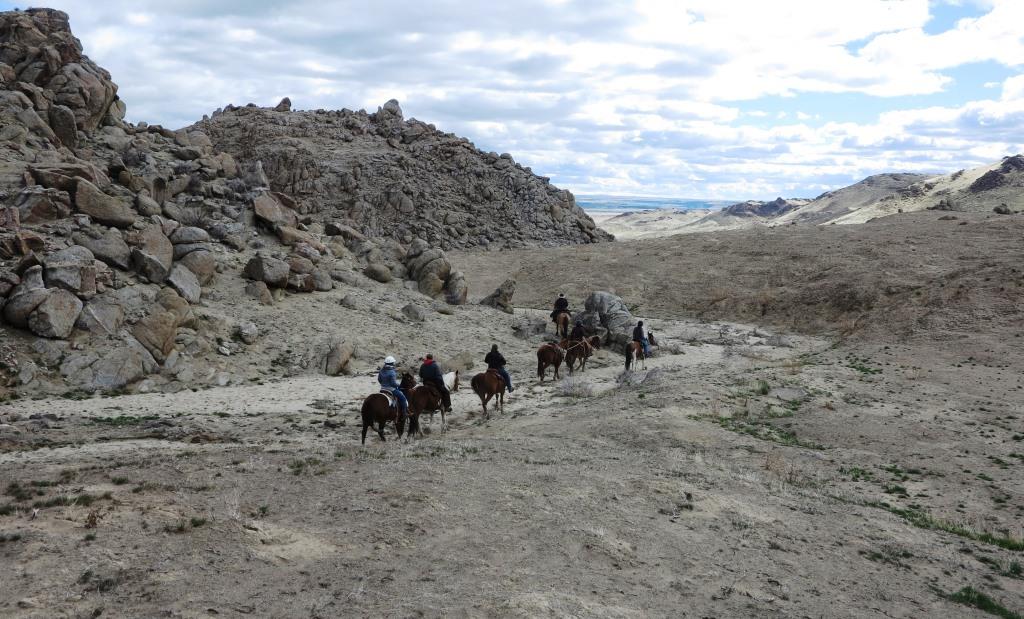
 When all were back at the trailers after a nice four hour ride, finger food was shared and stories told. See more Pictures See Video
When all were back at the trailers after a nice four hour ride, finger food was shared and stories told. See more Pictures See Video

BCHI Members,
Thank you so much for the opportunity to join you, the State Board of Directors and also members of BCHI at your annual state convention! It was great to meet you all and learn more about the great work the chapters are doing throughout Idaho, as well as share information and answer questions about the Forest Service’s saw policy.
I’m always amazed at the dedication and amount of volunteer and partner work that BCH members give – you are all very much appreciated not only for the time and talent you give, but also for your passion for public lands. Thank you!
Here’s some additional follow-up items for everyone:
• The first is a letter from our Regional Forester here in R1 announcing our new Northern Region Wilderness Skills Institute, that will be occurring in Powell, ID the week of May 21-25; additional information is also in this email if folks scroll below. If folks have an interest, I would recommend signing up soon, per the highlighted link below, as I anticipate the sessions will fill up fast.
• The name of the R4 Saw Program Manager is Brian Burbridge and he can be reached at phone: 801-531-5320 or bburbridge@fs.fed.us. I would recommend that local chapters first contact the primary ranger district staff that they work with to see about saw training opportunities locally; if none are available, the district staff can work with/contact Brian to see about setting something up or seeing where trainings are being offered that folks can attend.
• The R1 Saw Program Manager is Todd Wilson. He is working with local ranger districts directly to set up saw trainings so I would recommend that chapters on the Idaho Panhandle and Nez Perce Clearwater NFs work directly with their local unit contacts first or with BCH volunteer sawyers Jerry Lange and Joe Robinson re: setting something up.
o R1 (Northern Region) covers the Idaho Panhandle NF and the Nez Perce Clearwater NF
o R4 (Intermountain Region) covers the Payette, Boise, Salmon Challis, Sawtooth, and Caribou Targee NFs
o It’s important to note that BCH volunteer C level instructor or evaluator sawyers need to coordinate with local FS units to set up cutting areas for training; volunteer sawyers also need a letter of designation from the Regional Saw Program Manager in order to instruct/evaluate. The FS (either FS line officer, Regional Saw Program Manager, or delegated forest/district saw program coordinator) is the “certifying official” who signs the saw card, based on recommendations from the saw evaluators.
• Conservation United (www.conservationinsurance.com or phone (844-559-8336) is the company that, as of a year ago, sounded like they also offered insurance (workers compensation) coverage for volunteer and partner groups using volunteers. They provide insurance coverage for many youth corps groups around the country, including youth corps using veterans engaged in hazardous fuels reduction (i.e., chain saw) work, and they had indicated to me that they also can provide insurance for volunteers. Not sure current status/current policies they offer but folks might want to visit with them to see what they currently offer.
Hope this is helpful for folks. Again, really appreciated being able to share some information on the saw policy and spend some time together. I look forward to seeing you all again soon!
Informal Letter 1 Signature Saw Policy Key Points – Volunteers and Partners
Apply to attend the 2018 Northern Rockies Wilderness Skills Institute!
Where: Powell Ranger Station, Powell, Idaho
When: May 21, 2018 – May 25, 2018
What: A skills building opportunity for wilderness field staff.
How: Select a Track (1, 2, 3, 4 or 5) and a lodging option below and click on the Apply Now button to be taken to registration.
Deadline: The application period will close April 9, 2018 at 5:00 pm Mountain Daylight Time.
Questions: Contact Jimmy Gaudry or Heather MacSlarrow with questions.
The Northern Rockies Wilderness Skills Institute is for agency staff and partner organizations that work in wilderness. This week long course offers five levels of training, with plenty of time for networking and growing community in between.
Tracks
The Northern Rockies Wilderness Skills Institute offers 5 tracks, based on your level of experience and the skills you would like to gain. Due to limited capacity, not every applicant may be able to attend their first choice Track. Therefore, during the application process, you will identify your top two choices for which Track you would like to be in. PLEASE NOTE the required pre-requisites for each track, and be prepared to furnish the appropriate documents and certifications when asked. Information about each Track is as follows:
TRACK ONE: Advanced Crosscut Saw and Axemanship; and Crosscut Saw and Axe Train the Trainer Course
PRE-REQUISITE: Letter of recommendation from line officer (agency staff) or direct supervisor (partner organizations).
Participants will learn policy, vernacular, OSHA requirements, delegations and designations as well as other requirements for navigating saw policy. They will also learn about the new curriculum, new teaching aids, new methodologies and processes for saw training (1/2 day). There will then be a field focus on axemanship, complex and precision falling, OHLEC, complex bucking, removing hung trees (with and without rigging) and following the new education methodology (1.5 days). The newly certified educators will the put on a class for new sawyers (2 days).
TRACK TWO: Crosscut Saw B Bucking and First Aid/CPR
PRE-REQUISITE: None.
This session is focused on gaining the qualifications needed to be a crosscut saw B bucker. Participants will also learn basic wilderness stewardship principles, leave no trace, horsemanship, and trail maintenance techniques.
The first aid/cpr session will provide participants with basic first aid and CPR skills required to work with a crosscut saw.
The A/B Crosscut Certification Course provides students with both classroom-based instruction and field experience in the use of the crosscut saws and axes. Students will learn how to safely utilize these tools in a trail maintenance capacity. The course will cover tool history, best practices in the field, one-on-one instruction in tool use in the field, tool care, safety, and transportation of the tools. Successful completion of this course is required to use these tools on national forest lands while participating in stewardship efforts.
Participants will also learn/review basic wilderness stewardship principles, leave no trace, horsemanship, and trail maintenance techniques.
This is a field based course so come with appropriate outdoor gear and a sack lunch both days. If you have a favorite set of tools please bring those as well.
TRACK THREE: Crosscut Saw B Bucking and Basic Trail Maintenance
PRE-REQUISITE: First Aid/CPR Card.
This session is focused on gaining the qualifications needed to be a crosscut saw B bucker. Participants will also learn basic wilderness stewardship principles, leave no trace, horsemanship, and trail maintenance techniques.
The basic trail maintenance session will provide…
The A/B Crosscut Certification Course provides students with both classroom-based instruction and field experience in the use of the crosscut saws and axes. Students will learn how to safely utilize these tools in a trail maintenance capacity. The course will cover tool history, best practices in the field, one-on-one instruction in tool use in the field, tool care, safety, and transportation of the tools. Successful completion of this course is required to use these tools on national forest lands while participating in stewardship efforts.
Participants will also learn/review basic wilderness stewardship principles, leave no trace, horsemanship, and trail maintenance techniques.
This is a field based course so come with appropriate outdoor gear and a sack lunch both days. If you have a favorite set of tools please bring those as well.
TRACK FOUR: Beginner/Intermediate Wilderness Stewardship
PRE-REQUISITE: None.
This session will focus on the skills needed to be a wilderness ranger. It will provide learning and engagement opportunities for a beginner to intermediate participants. This session will include fundamentals related to the wilderness act and wilderness character monitoring. Basic wilderness stewardship principles, roles of the wilderness ranger, making public contacts, backpacking skills, leave no trace, horsemanship, and trail maintenance techniques will also be a part of the session.
TRACK FIVE: Intermediate/Advanced Wilderness Stewardship
PRE-REQUISITE: None.
This session will focus on the skills needed to be a wilderness ranger. It will provide learning opportunities for the intermediate/advanced participants. A deeper dive into wilderness policy and law, wilderness stewardship performance, and wilderness character monitoring will be included. It will also allow participants to take on thought provoking topics related to emerging issues, volunteer project management, and minimum requirements decision guides. Since this is a more advanced session the participants may be asked to lead a session or discussion.
Lodging
There are two types of lodging available – tent camping (nestled amongst the pines and under the stars on the banks of the Wild and Scenic Lochsa River), or indoor bunkhouse style lodging. There are a limited number of indoor spaces. Please state your preference when submitting your application, and tell us about any special accomodations you may need.
Food
Food is not provided. It will be up to each participant or participant group to furnish their own food. There is limited indoor cooking space, as well as outside areas suitable for camp stoves, grills, and fires.
What to Bring, How to Get There, and More Information
An informational packet will be mailed to all participants at least two weeks prior to the start of the Northern Rockies Wilderness Skills Institute that lines out what to bring, how to get to training, and more important information.
Timeline
Application Period: March 9, 2018 – April 9, 2018
Application Review: April 9, 2018 – April 22, 2018
Applicant Notification: April 23, 2018
Informational Packet E-Mailed to Participants: May 7, 2018
Northern Rockies Wilderness Skills Institute: May 21, 2018 – May 25, 2018
===========================================
Subject: Northern Rockies Wilderness Skills Institute – Applications Due by April 9
Please share with employees and partners. See link for more information.
The Northern Region will host the Northern Rockies Wilderness Skills Institute (NRWSI) in cooperation with partners from across the Region. The dates for the NRWSI will be May 21 – 25, and it will be held at the historic Powell Ranger Station in Powell, Idaho.
This training is open to all Forest Service employees and partners. There may be a need to limit the number of participants in each session. Applying early is highly encouraged.
Applications may be submitted until April 9, 2018. A description of the sessions are offered along with application information can be found at Northern Rockies Wilderness Skills Institute.
For information concerning the NRWSI, contact Jimmy Gaudry at jcgaudry@fs.fed.us, Kent Wellner at kwellner@fs.fed.us, or Joni Packard at jpackard@fs.fed.us.
The 2018 BCHI Spring Board Meeting & Convention was hosted by the “Twin Rivers” chapter in Clarkston, WA.( Clarkston is a city in Asotin County, Washington, United States. It is part of the Lewiston metropolitan area, and is located west of Lewiston, Idaho, across the Snake River. The population of Clarkston was 7,229 in 2010 census.) The Board Meeting was held on Friday March 9th and was attended by members, Bill & Marybeth Conger, Phil & Kay Ryan, Lynn & Peggy Garner. Bill Holt attended the BCHI Foundation meeting during the same time.
 Rob Adams arrived around 16:30 just at the meeting was breaking up and joined the group with the addition of Christ Holt for happy hour. During the social hour members from the various chapter swapped stories and planned where to get dinner.
Rob Adams arrived around 16:30 just at the meeting was breaking up and joined the group with the addition of Christ Holt for happy hour. During the social hour members from the various chapter swapped stories and planned where to get dinner.
Starting sharply at 08:00 Saturday morning, Bill Conger graveled the convention to order and issues talked about at the board meeting were voted on. A guest speaker from district one of the USFS talked about progress being made on the national sawyer program and how both district one and four were doing implementing it. Jeff Halligran from the “Idaho Trails Association” talked about his organization, requested help with packing support, and gave an interesting presentation on cross cut saws.
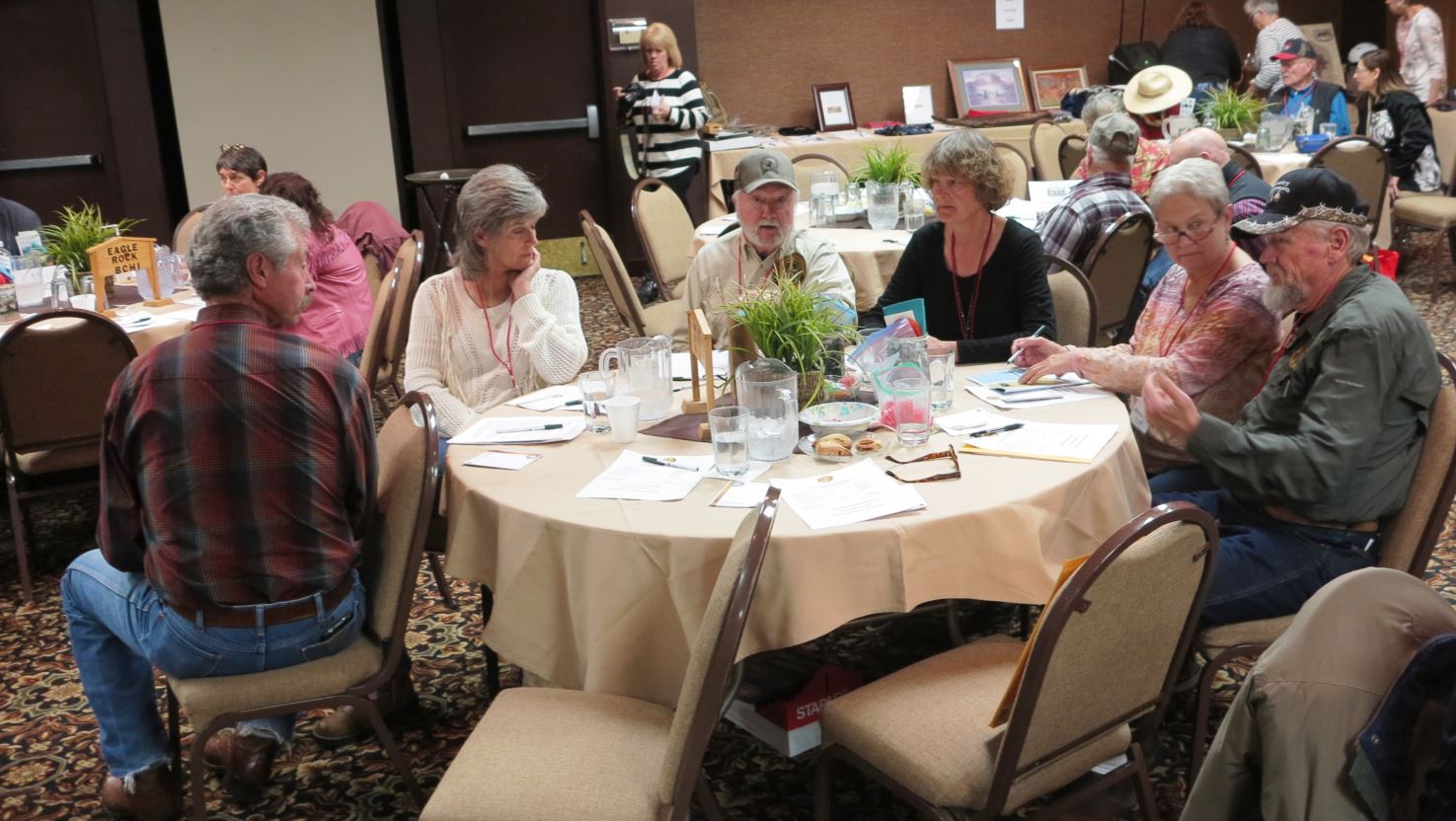
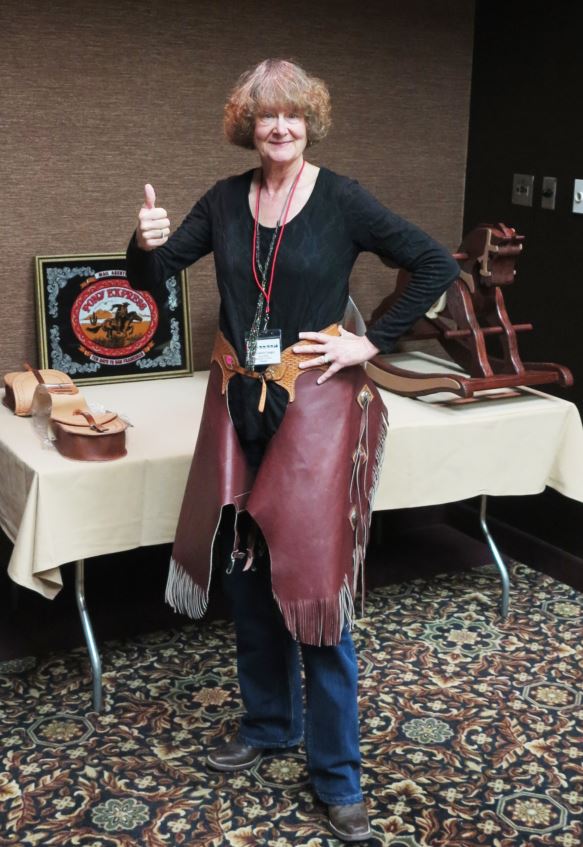 Lunch was served and the afternoon was spent in various training sessions, and group discussions. While all this was going on, BCHI members were checking out the auction items. After a great dinner of either prime rib or seasoned chicken breast, the winners of the chapter displays and photo contests were announced.
Lunch was served and the afternoon was spent in various training sessions, and group discussions. While all this was going on, BCHI members were checking out the auction items. After a great dinner of either prime rib or seasoned chicken breast, the winners of the chapter displays and photo contests were announced.
 Squaw Butte was awarded second place in the chapter displays (see other displays) and took top honors in the photo contest.
Squaw Butte was awarded second place in the chapter displays (see other displays) and took top honors in the photo contest.
 Laurie Bryan took both first and second prizes for her photo’s of Janelle Weeks & Shelly Duff.
Laurie Bryan took both first and second prizes for her photo’s of Janelle Weeks & Shelly Duff. David Benson’s mule picture took a first place in the animal division and Rob Adams picture of Payette sticking his tongue out won third prize.
David Benson’s mule picture took a first place in the animal division and Rob Adams picture of Payette sticking his tongue out won third prize.
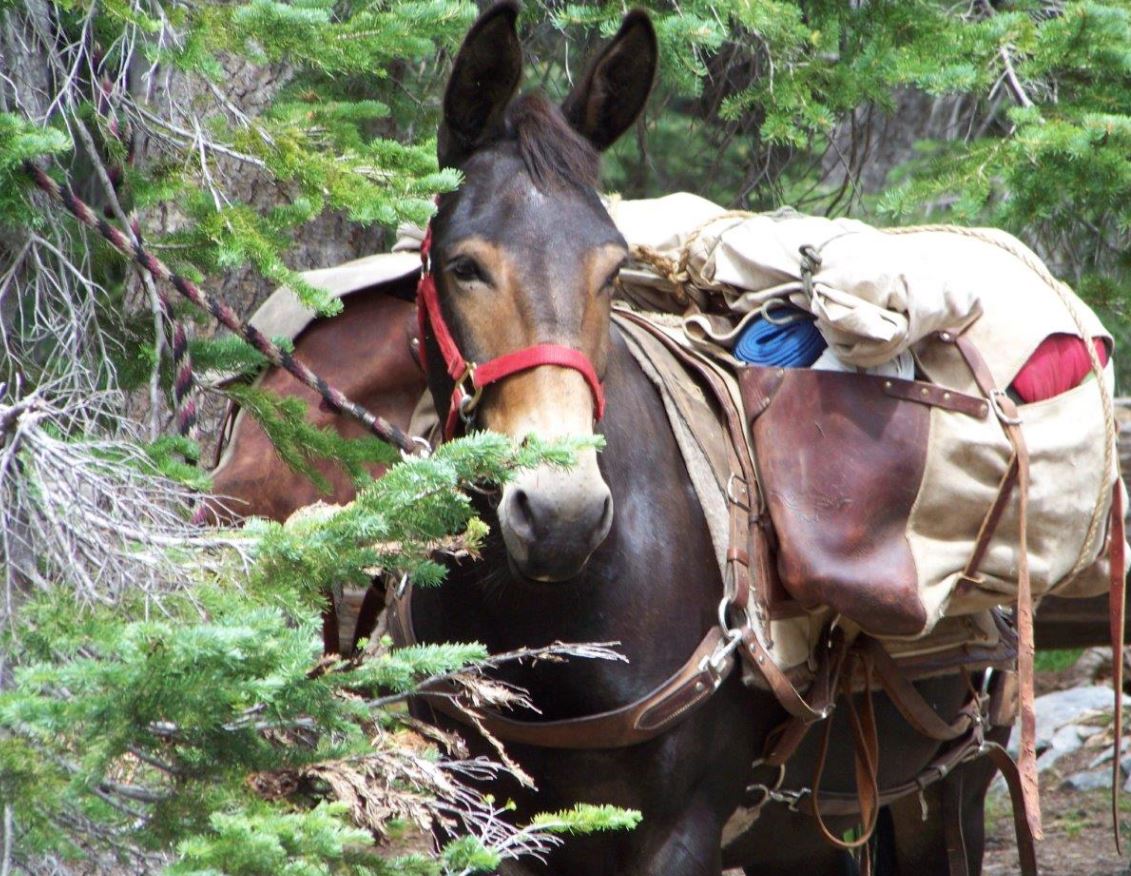
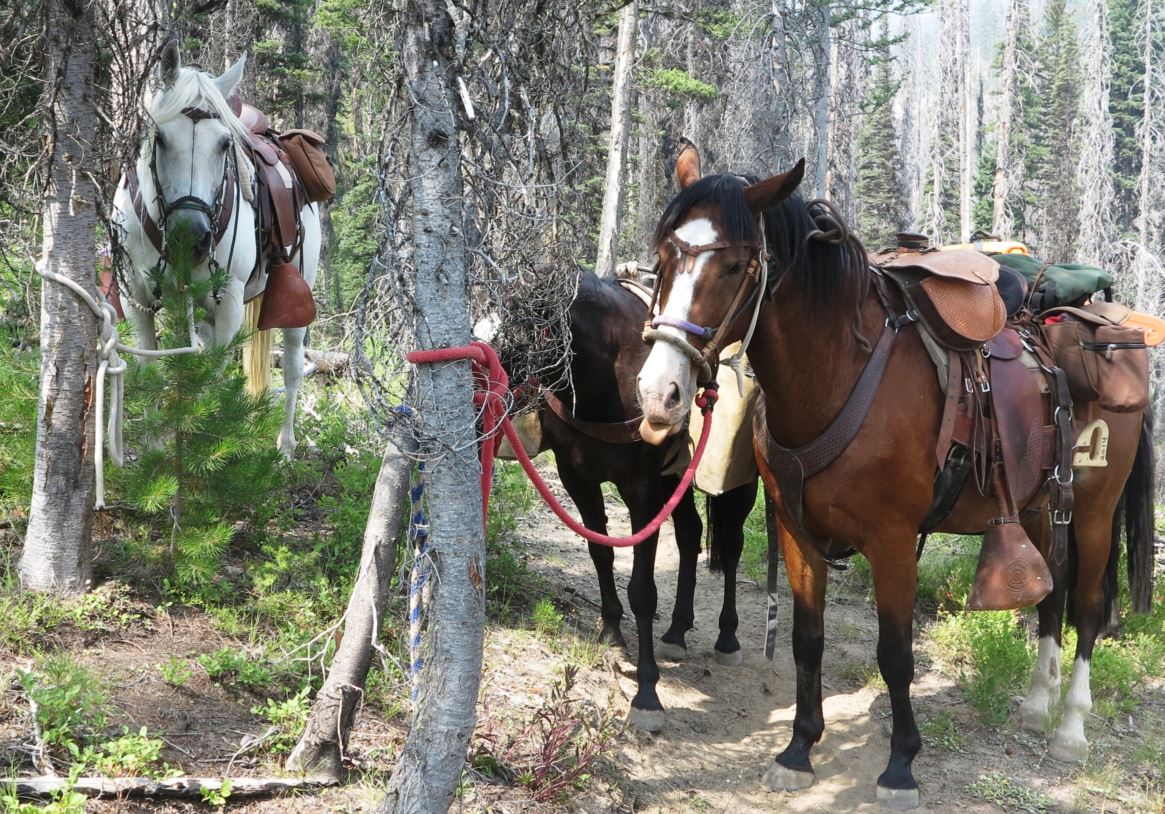 The auction followed, with lively bidding that was somewhat hampered by the high noise level in the room. Some great items were taken home by members and the coffers of the foundation were expanded.
The auction followed, with lively bidding that was somewhat hampered by the high noise level in the room. Some great items were taken home by members and the coffers of the foundation were expanded.
Michaela Myers said she was first groped by her supervisor after a crew pizza party last summer, shortly after starting a new job as a firefighter with the U.S. Forest Service. She was 22 and excited about the job. She had worked out diligently to prepare for the season, running and hiking with a heavy pack. She is from the Pacific Northwest, and had always loved the outdoors and a challenge.
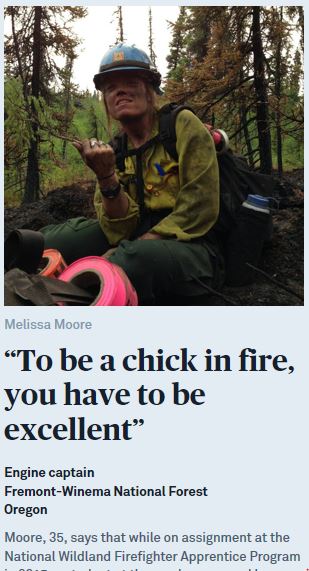 She remembers her supervisor, Drew DeLozier, a Forest Service veteran, offering her beers at a crew member’s house after dinner. He told her he was glad she was on the crew because she was “sexy” and had “a nice ass,” she said. According to her account, he led her to a couch, rubbed her butt as she sat down, and slid his hand between her legs. Myers was shocked and upset, but didn’t stop him. She had heard from other crew members that DeLozier could fly off the handle, and didn’t want to make a scene.
She remembers her supervisor, Drew DeLozier, a Forest Service veteran, offering her beers at a crew member’s house after dinner. He told her he was glad she was on the crew because she was “sexy” and had “a nice ass,” she said. According to her account, he led her to a couch, rubbed her butt as she sat down, and slid his hand between her legs. Myers was shocked and upset, but didn’t stop him. She had heard from other crew members that DeLozier could fly off the handle, and didn’t want to make a scene.
“You don’t feel like you can say ‘no’ loudly to your supervisor,” she said. “I keep looking back on it and wishing I could have just punched him or something.”According to Myers, the harassment and groping continued for the rest of the summer. When she confided in a fellow crew member, he told her this was an unfortunate reality for a female firefighter. She had a choice, she recalls him saying: report it and face retaliation, or do nothing and stay in fire.
But in September, after the end of her three-month season in Oregon, Myers had enough. She reported the harassment to the United States Department of Agriculture, the Forest Service’s parent agency. In October, she provided a sworn statement to a USDA investigator detailing all the allegations. At first, Myers found the Human Resource department’s response encouraging. She was optimistic action would be taken. But two months later, the Forest Service sent her a letter that said the investigation was complete, no misconduct had been found, and the case was closed.
Myers was furious.
“This means they don’t believe me that I was sexually harassed,” she said. “Or they don’t care.”
When reached by phone, DeLozier, who still works for the Forest Service, said he was made aware of the allegations. “I was cleared of all wrongdoing,” he said.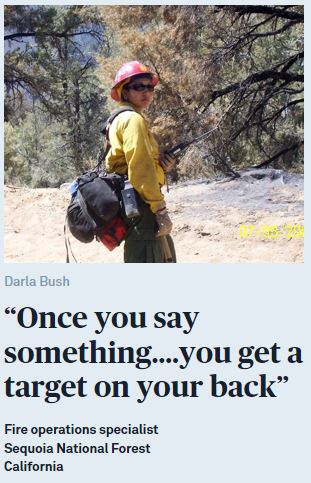 ‘We all live in this fear’
‘We all live in this fear’
Harassment of women in the Forest Service has been a problem for years. As far back as 1972, women have joined together to file class action complaints and lawsuits about gender discrimination and sexual harassment. More recently, in 2016, a congressional hearing was held to address the problem within the Forest Service’s California workforce, which had also been the focus of previous complaints. The PBS NewsHour investigated what’s happened since then, and found the problem goes much deeper. READ MORE
Guides, outfitters, Public land agencies, non-profits and sportsmen of all stripes converge here for a gear-filled good time. With tips on fishing, hunting, elk calling, and more, there’s plenty to do for those who chase the call of the wild. There’s even stuff for the kids with an archery shoot, live trout pond, and other fun things to hunt out.
For the four days of the Idaho Sportsman show, members from three BCHI Chapters and members of the Idaho Trail Association manned a booth on the east end of row “D” next to the US Forest Service Booth at Expo Idaho (fair grounds). These trail ambassadors handed out information about volunteer trail work and their organizations and talked to many of the shows visitors.
It was also a good time to hang out with other chapter members and talk about the upcoming year. Members of BCHI who participated: Janelle Weeks, Lisa Krogh, Jim & Bonnie Fox, Gary & Ann Hale, Dan Pryse, Lynn & Peggy Garver, Carmen Tyack, Bill and Marybeth Conger, Nancy Smith, Shannon Schantz, Gary Towle, Donnie & Erin Thornugh, Paul & Jill George, David Benson, Phil & Kay Ryan, Joe Williams, Janine Townsend, Bill Holt, Dick Peterson and Rob Adams. Bryan DuFosse coordinated the ITA members who worked the booth.
 Last August in Idaho a woman was attacked by a bear. For weeks afterward, local newspapers printed page upon page about the encounter, warning their readers that dangerous animals were prowling the countryside. What if you were planning a ride or a horse camping trip when you read about this attack? Would you stay home, take extra precautions, or venture elsewhere?
Last August in Idaho a woman was attacked by a bear. For weeks afterward, local newspapers printed page upon page about the encounter, warning their readers that dangerous animals were prowling the countryside. What if you were planning a ride or a horse camping trip when you read about this attack? Would you stay home, take extra precautions, or venture elsewhere?
The great counterweight to the lure of the outdoors is the fear of the unknown. What if the weather turns for the worse? What if my horse acts up? What if I become lunch for a grizzly?
Here’s the hard truth. Most people spend entirely too much time and energy worrying about menacing—but low-chance threats like bears, cougars, and wolves, and not nearly enough thought concerning themselves with the dull and common dangers like bees, blisters, and hypothermia. To confirm this theory, take a quick test. How many times have you been mauled by a bear or a mountain lion? Now compare that figure with the number of times you’ve forgotten a piece of tack, dealt with an unruly horse, or encountered bees on a ride.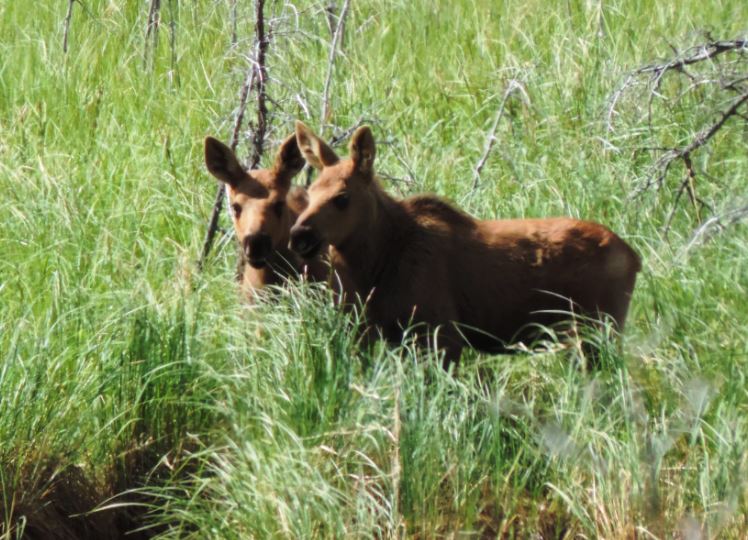 One reason that riders and campers worry about the wrong things is largely the fault of the media, and writers like me. Adding the phrase “When Grizzlies Attack!” to a title sells more magazine copies, even if your chance of having a stand-off with a bear is much less than that of having a winning lotto ticket magically appear in your saddlebags.
One reason that riders and campers worry about the wrong things is largely the fault of the media, and writers like me. Adding the phrase “When Grizzlies Attack!” to a title sells more magazine copies, even if your chance of having a stand-off with a bear is much less than that of having a winning lotto ticket magically appear in your saddlebags.
I’m not suggesting that you ignore potential threats like bears, wolves, and cats, but to drop them a few rungs down the worry list. Obviously, if you’re riding or camping in an active bear area, take sensible precautions like making noise, bear-bagging your food, and avoiding huckleberry thickets. But don’t fixate so much on these critters that you spook at every rustle of the leaves, or even worse, fail to enjoy the ride and the trip. It all comes back to the most important outdoor skill anyone can practice: common sense.
Ignoring the hysteria can be hard to do and less than exciting. On rides with my wife, I’ve been guilty of pointing into the forest and reminding her that there are undoubtedly creatures watching us as they sulk in the darkness. For some reason, Celeste doesn’t seem to appreciate my wickedly keen sense of observation. Here are a few words to the wise. Firstly, don’t alarm your wife, husband, riding partner, or others with tall tales of the abundance of apex predators. Secondly, prioritize your outdoor concerns with the help of these two lists.
Pay More Attention to These…
Worry Less About These…
Next month we’ll discuss preparing for your first backcountry horse camping trip. Until then visit www.TrailMeister.com for the largest and most comprehensive guide to horse trails, horse camps, and the tips and knowledge to enjoy them! In February, you’ll also find me teaching the tips and tricks of trail riding at clinics in Idaho and Tennessee. Check the website for details.
From: Idaho Horse Council [ idahohorsecouncil@yahoo.com ]
Sent: Monday, February 19, 2018 12:00 PM
Subject: Idaho Brand Inspection
Members we need your help!
Representative Judy Boyle will be introducing a Bill soon that will eliminate the need to get a Brand Inspection on equine in Idaho.
She did not make the industry aware of this bill, nor why she felt the need to try and eliminate Brand Inspections for Equine in Idaho.
Please contact Representative Boyle and your legislature representative. It’s important the Industry for the following reasons to continue to have Brand Inspections. Please post on face book pages and email your equine friends and please Call or email your representatives.
Representative Judy Boyle jboyle@house.idaho.gov
Home (208) 355-3225
Bus (208) 355-3225
FAX (208) 355-3225
 H602 Statement of Purpose H0602 brand inspections
H602 Statement of Purpose H0602 brand inspections
Value of Brand Inspections
Brands are livestock’s return address. They are important because:
• They provide evidence of ownership
• They deter theft
• They enable brand inspectors and law enforcement personnel to return stolen or missing livestock to their owners
• They help resolve conflicts over ownership
Deters theft
• Helps determine ownership
• Enables brand inspectors and law enforcement personnel to return stolen or missing livestock to their owners
• Prevents unlawful sale or transport of livestock
• Facilitates commerce by providing a system of checks and balances that is well understood and valued in the marketplace
• Helps protect the livestock industry by putting trained personnel in the field to keep an eye on the industry
Several of our surrounding States require a Brand Inspection to bring a horse into their State.
In case of a disaster how would we find our livestock?
If Brand inspection for Equine is eliminated the Idaho Horse Board would no longer be able to grant funds on a yearly basis ..Since 1989 the Idaho Horse Board has granted $478,495.for Research, Education and Promotion for Equine Groups in Idaho .
If she eliminated brand inspections on Equine then would they need to reclassify the definition of livestock as the law now exists. Equine may no longer be classified as “Livestock.”
Thank You
Debbie Amsden
Executive Director
Idaho Horse Council
(208) 465-5477
idahohorsecouncil.com
~-~-~-~-~
BCHI Chapters: Idaho Brand Inspection
Directors and Presidents, please encourage your members to contact their State Legislators regarding this purposed bill which I have attached along with Boyle’s Statement of Purpose for the Bill. Boyle states that passage of this bill would save the Brand Department $528,000 which I understand from a member of the Brand Board is not correct. I was told the savings would be about $300,000.
The important point to the $300,000 is that what we currently pay for our equine brand inspections does not cover the full cost of conducting these inspections. Therefore other brand inspection fees, such as cattle, are used to subsidize ours which means someday we should expect to pay our true costs.
Bill Conger
BCHI Chairman
208-369-0768
chairman@bchi.org
Here’s what the Land and Water Conservation Fund does
As part of a budget proposal that amounts to a Valentine to special interests, the Trump administration wants devastating cuts to the Land and Water Conservation Fund, which has been called America’s most important conservation tool. Learn more here.
President Trump’s Fiscal Year 2019 federal budget proposal would cut the long-running and popular Land and Water Conservation Fund (LWCF) to the bone, reducing its budget by roughly 90%. LWCF was designed so there would always be money available for its core purpose of protecting land in order to complete national parks, forests, wildlife refuges and other protected sites, without burdening American taxpayers. For over 50 years, it has drawn on revenues from oil and gas drilling on the Outer Continental Shelf to pay into thousands of projects nationwide, gaining popularity across the political spectrum.
But despite broad bipartisan support for the program, billions of dollars have been diverted from the Land and Water Conservation Fund by Congress over the course of the program’s life to pay for unrelated expenses, leaving many outdoor projects unfinished and parcels of land unprotected. In recent years, funding for LWCF has hovered around one-third of the full authorized level, even as new pressures intrude on wildlands and shared spaces become developed, fragmented or otherwise damaged.
The Trump proposal would devastate this popular program already hanging on for dear life, representing the single largest cut in the already weakened Department of the Interior’s budget. We will ask lawmakers to reject Trump’s reckless budget and persist with a larger campaign to demand permanent reauthorization and full funding for LWCF.
READ MORE
This year’s 40 years down the trail convention has something new for all you amazing BCHI members, says BCHI Education chair, Marybeth Conger.
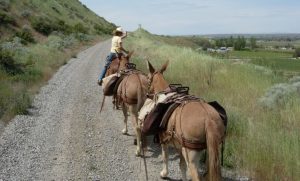
Saturday, March 10th from 1:00 until 4:30, there will be the first ever BCHI Chapter Member Training workshops. Training covers various chapter positions and other pertinent educational topics. These training workshops are listed below along with the name of the instructor.
Chapter President/ Vice President– Bill Conger and Rod Parks
Chapter Secretary– Debbie Samovar
Chapter Treasurer– Kay Ryan
BCHI Foundation and Amazon Smile fundraising– Chris Reed and Bill Holt
Volunteer Hours reporting– Rod Parks
Back country Horseman of America– Steve Didier
Idaho Horse Council & BCHI Website– Raenette Didier and Jill Nebeker
Chapter Education Chair– Marybeth Conger and Karen Kimball
Also, at the Friday, March 9th State Board of Director meeting, Steve Didier is presenting to the directors a training workshop covering State Director/National Director. Members are welcome to attend too. So please come join us at this year convention for some great learning, fun, and comradery . The workshop schedule will be posted on the BCHI website too. If anyone has questions, about the training workshops, please reach out to Marybeth Conger at b.mbconger@gmail.com.
by Tom Ribe Link to online Posting
Tom Ribe is a contributor to Writers on the Range, the opinion service of High Country News. He writes from his office in the wildland-urban interface in Santa Fe, New Mexico.
Two days after President Donald Trump signed an executive order reducing Grand Staircase-Escalante National Monument by half, Utah Republican Rep. Chris Stewart introduced a bill in the House that would put local politicians in charge of the public lands cut away from the monument.
One tenet of conservative public-land policy orthodoxy is that local control of public lands will improve the wellbeing of local residents. Yet the movement to auction off federal lands or transfer them to state or county control has repeatedly run aground because public lands are overwhelming popular among Americans. Other conservative efforts have been sought to neutralize federal agencies.
Stewart’s Grand Staircase-Escalante Enhancement Act is one of these new approaches. If passed by the House, it would create a ‘management council’ made up of seven local county commissioners and state legislators appointed by the president of the United States. One member would come from the Department of the Interior. The management council would set policy for two small Bureau of Land Management national monuments and one new national park and preserve under the jurisdiction of the National Park Service. The three areas lie within what once was the Grand Staircase-Escalante National Monument created by President Bill Clinton and managed by the BLM.
Stewart’s legislation states that federal land managers “shall adhere” to management plans created by the management council. If recent experience with a similar scheme at the Valles Caldera National Preserve in northern New Mexico is any guide, this approach is doomed to failure. Valles Caldera: About 1.25 million years ago, a spectacular volcanic eruption created the 13-mile wide circular depression now known as the Valles Caldera. The preserve is known for its huge mountain meadows, abundant wildlife, and meandering streams. The area also preserves the homeland of ancestral native peoples and embraces a rich ranching history.
In 2000, after a 100,000-acre private parcel surrounded by Forest Service and National Park Service land came up for sale near Santa Fe, public pressure encouraged the New Mexico congressional delegation to buy it for the public. But Sen. Pete Domenici, R-N.M., insisted that a presidentially appointed, mostly private-sector board of trustees set policy for the new preserve as an “experiment” in management. Federal employees would carry out the board’s policy.
Problems dogged the experiment from the start. Having the president appoint board members politicized the board. When Republicans controlled the House of Representatives, ranching-oriented board members were selected; when Democrats controlled the House, conservationists and academics ran the board. The federal staff had to answer to nine ever-changing bosses whose edicts sometimes conflicted with the federal laws that apply to public lands.
Stewart’s bill would ensure that only Republicans would be appointed to the management board — unless some seismic shift were to happen in Utah politics. Lands owned by all Americans would be governed by local people with local interests, and if the management council mandated policies that violated federal laws, the federal staff would have a choice of either violating the law or disobeying their local bosses. One can imagine the lawsuits likely to follow.
Stewart would clearly prefer to transfer these lands to county ownership. But that would run counter to strong public support for federal land management, and it would upset the tourism-oriented businesses that have thrived ever since Grand Staircase-Escalante National Monument began drawing tourists and boosting property values.
Stewart is hoping to mollify these business interests by creating a new little national park. Yet this so-called park mandates livestock grazing and hunting and trapping, and it would be controlled by state game officials and members of the management council. The mandates could force the National Park Service to violate its own Organic Act, opening up both the management council and the federal government to lawsuits.
Stewart’s bill, which has three co-sponsors from Utah, mandates livestock grazing “in perpetuity” on all the lands in question, but makes no mention of administrative costs or the collateral damage of livestock grazing in a rocky desert where little forage grows. Grazing can be mandated, but what happens when there’s a drought?
The public in New Mexico, after 15 years, was frustrated with the “seat of the pants” decision-making by the board of trustees at the Valles Caldera National Preserve. In 2015, Congress transferred the preserve to the National Park Service, which imposed its standard management structure.
Stewart’s bill, combined with Trump’s evisceration of the Grand Staircase-Escalante National Monument, may advance conservative public-lands ideology. But neither action advances the interests of the public, and both create far more problems than they pretend to solve.
There has been a lot of attention recently about Public Lands and where America is headed with the management of those lands. Further, anyone who recreates on Americas public lands is often exposed to unfamiliar terms and may not understand the differences. Following is a brief description to give you a working understanding of the differences and what that means to you.
First, what are “Public Lands”? These are the lands that are owned “equally” by all Americans. There are 618 million acres of public land across the U.S., with a significant portion in Alaska and the western U.S. The total U.S. land base is 2.27 billion acres in size. These federal public lands are managed in trust for us, (citizens of the U.S.) by the Forest Service, Bureau of Land Management, Park Service and the Wildlife Refuge System for current and future generations.
“Front country” is not a commonly used term, but is generally any public lands that are relatively accessible by means such as motor vehicles, boats, bicycles, hiking, horseback and aircraft and are usually within a short distance of roads. Generally, these lands provide a multitude of recreational activities. Camping may be in developed or dispersed/undeveloped areas. Logging, grazing and mining are often permitted on these lands as well. These are often highly used areas where it is common to see other people and activities.
“Backcountry” is generally the area beyond what is Front country. Pretty vague, but accurate. There is no specific line or map designation where this starts or ends. Access is more challenging and is usually by a trail or cross-country travel and at a further distance from roads and trailheads. Access may be allowed by the same list as above, but with greater responsibility on the user as trails receive less maintenance. In addition, the safety and welfare of each recreationist to care for themselves is increased. Camping is usually in dispersed sites. You would expect to see fewer people and activities than in the Front country.
“Roadless Areas” had their beginnings when Primitive Areas were established in the 1920’s. The idea was to preserve some lands in a roadless condition at a time when automobiles and road building was rapidly expanding. As time progressed, Roadless Areas have been challenged legally and politically as to which lands should remain or be opened. Currently, there is about 58 million acres of unroaded forests. There is about 380,000 miles of roads on Forest Service lands. In comparison, the Interstate Highway system has about 47,000 miles of road.
Unlike Front country and Backcountry, “Wilderness” is defined and receives that highest level of land protection. While some may get a “wilderness experience” in the Front country or Backcountry or a Park, true Wilderness is a specific geographic area and can only be established or “Designated” by an act of Congress. The Wilderness Act of 1964 put into law what is required to be a “Designated Wilderness”. It states how it will be managed and what modes of access or travel are acceptable. The Act requires that it be managed to protect its natural condition, where it is untrammeled by man. It is to maintain its primeval character, shaped by the forces of nature with man’s work substantially unnoticeable. The purposes will be to provide solitude, and escape from mechanized use and maintain historic uses.
Three more terms that you may hear. “Recommended Wilderness” is generally lands identified on Forest Plans or agency plans that recommend specific areas for Wilderness Designation by Congress. “Proposed Wilderness” is generally lands that have been submitted to Congress for Wilderness consideration, a step closer than recommended. However, these two terms can mean the same thing depending on the agency. Finally, “Wilderness Study Areas” or WSA’s are areas that are inventoried and undergoing the Wilderness review process. They are lands that should be managed to preserve the character or special attributes that made them a WSA.
Parks generally have defined geographic areas which are indicated on maps. The recreational uses within a Park are often highly regulated due to a significant amount of visitor use. There are 58 National Parks, and most are associated with a specific national treasure. Interestingly, some iconic National Parks like Yellowstone, Grand Teton and Glacier and others are NOT designated Wilderness. They are “recommended wilderness” but to date, Congress has not given them the additional level of protection.
Parks can be managed by a city, state, private or federal entity. The simplest definition comes from Wikipedia: A “Park” is an area of natural, semi-natural or planted space set aside for human enjoyment and recreation or for the protection of wildlife or natural habitats. It may consist of grassy areas, rocks, soil and trees, but may also contain buildings and other artifacts such as monuments, fountains or playground structures.
The vast majority of our public lands are managed under the multi-use designation that includes both the Front country and Backcountry. This allows for a multitude of activities to be offered on the majority of our Public Lands. Only about 3% of the lower 48 states land base is designated Wilderness.
Submitted by: Mack Long
Mission Valley BCH, BCH Montana, Education Chairman BCH of America
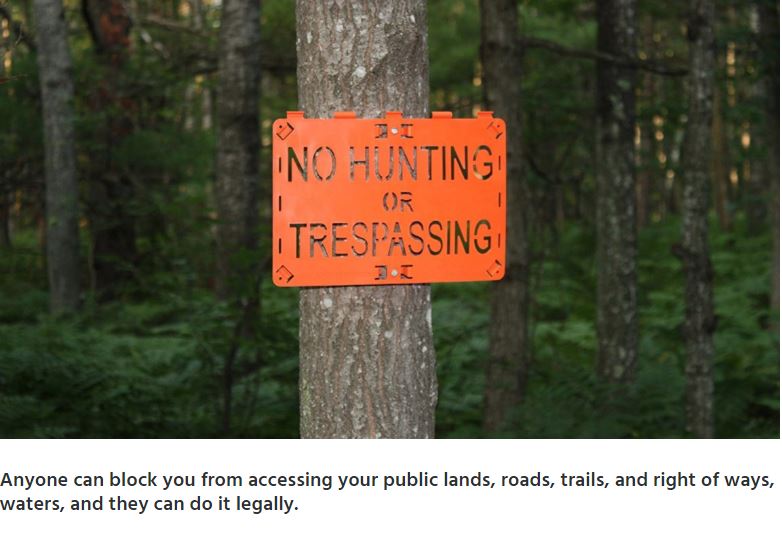
You read that right! There currently exists no Idaho law protecting your right to access public areas that you pay for. That means anyone can barricade a public tract and prevent your horse, ATV, or motorcycle from passage without fear of repercussion. And even more common, Idaho sportsmen are running into “NO TRESPASSING” signs on public lands and waters that they have every right to access. Don’t believe it? Check out this news story and the video of an encounter with an armed security guard patrolling a Forest Service road.
Right now, for instance, public funds can be used to purchase and maintain permanent, motorized public access on a road. Anyone can physically obstruct that road and block your access without fear of repercussion. Imagine your disappointment when you draw a coveted elk tag only to show up on opening day to find a locked gate across a public road. Sure you can call the local sheriff. But with extremely limited funding, and perpetrators with deep pocketbooks, local law enforcement simply can’t prioritize prosecuting these types of cases.
The scenarios are endless, but one thing is for sure, your right to access public property is not secure. IWF has been working with legislators, motorized recreation groups, and sportsman groups to close this loophole and create a succinct amendment to an existing law that will put the power of protecting public access in the people’s hands. To review the most updated version of the proposed legislation click here.
Have you ever seen signs or physical barriers to impeding access your public lands? Submit your story below and we will deliver your comments to our legislators. Link to IWF website

The Forest Service has standard drawings and design aids for the construction of trail bridges. The standard drawings/design aids have been designed and developed in accordance with Forest Service Manual and Forest Service Handbook directions. The following information is provided FOR REFERENCE ONLY.
All bridge drawings should be approved for each specific bridge by a qualified engineer with trail bridge design experience. Drawings are intended to provide ideas for layout and detailing. No drawing or detail should be used for construction without design review by a qualified engineer. Forest Service bridges must be approved and/or designed by the Forest Service engineer or manager responsible for engineering.
The drawings are not meant to be used as individual sheets and should not be used by themselves. A complete drawing package should be downloaded so that the designer has all the required information for reference. All drawings are in PDF format and can be viewed with Adobe Acrobat Reader.
Currently, only four regions within the Forest Service have standard drawings/design aids. These are Northern Rockies Region (R1), R6 Pacific Northwest Region (R6), Eastern Region (R9), and Alaska Region (R10).
There are two different ways to download the standard drawings/design aids.
The first way is to download a complete set of drawings in a single PDF. This method should only be used with a high-speed Internet connection.
The second way is to download each individual drawing in PDF. This method is recommended for dial-up connections.
The following resources give additional information on planning, siting, designing, constructing, inspecting and maintaining trail bridges. All of these items should be included in the decision process to select the best structure for aesthetic design, sustainability and longevity.
By Education Chair Marybeth Conger
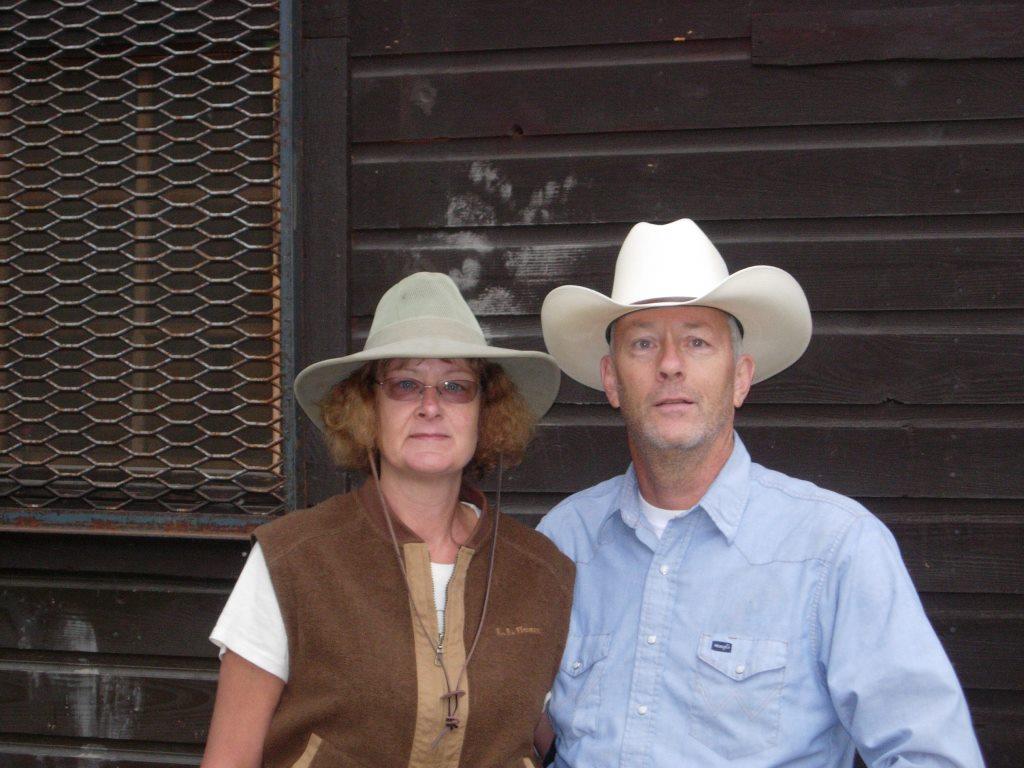
If you are still thinking about attending the Back Country Horseman of Idaho 2018 Directors meeting and Annual convention, please consider that chapter member education has been added to this amazing event. On Saturday March 10, the first ever, BCHI chapter training will be held in the afternoon. Presented by various volunteers, these educational workshops and presentations are open for all members to attend. What a great way to learn more about your current chapter position, or find out details about something you may be interested in the future. Some workshops even cover topics to help us better understand things and help BCHI grow in both numbers and membership development. With your attendance and feedback, we can make this training an annual BCHI event and improve, meeting your educational needs. Get your registration form completed and experience some fun learnings and comradery in additional to all of the other fantastic activities scheduled at the 2018 convention. Hope to see you all there!
April 13 – 15 marks the date for the 2018 Idaho Horse Expo held at the Ford Idaho Park. SBBCH members Bill and Marybeth Conger are some of the clinicians at this year’s event. Their pretentions will cover lightweight recreational packing and camping techniques. In addition, local BCH chapters will again man a BCHI booth. These types of public outreach events help the BCHI organization to grow and educate the public on the wise and sustaining use of our backcountry resource. So come join us if you can!
Karen Kimball graciously volunteered to be a BCHI education co-chair to help coordinate education efforts up north. Making sure chapter education chairs are familiar with all of the relevant education materials maintained by BCHA and its member states is one way for her to accomplish this. Thank you Karen!
Please let the education team know what you plan to accomplish in 2018 so we can spotlight more chapter activities. Education updates on the BCHI website are starting to happen and expect to see more once Marybeth successfully completes the Master Educator course. Well this covers the first quarter and then some. Happy Trails! 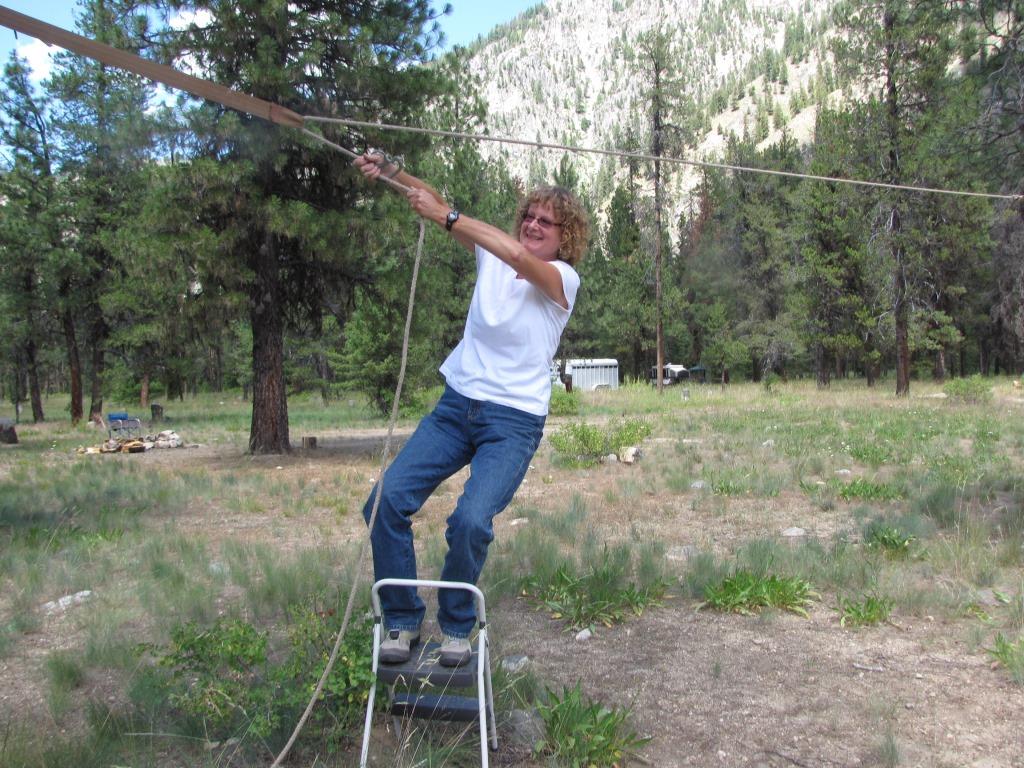
Wilderness Society
Interactive: Tracking Trump’s anti-public lands crusade
After a chaotic first year, the Trump administration has made it abundantly clear that one goal is to systematically sell out America’s public lands to the fossil fuel industry.
This interactive timeline examines all the actions taken by President Trump and Interior Secretary Ryan Zinke to give away our nation’s heritage to energy companies for unfettered drilling, fracking and mining.
How to use the timeline:
Use the bar at the bottom of this page to scroll through our timeline then click on each box for more info.
We’re not long into our hike along the snowy shoreline of Glacier National Park’s Lake McDonald when I pop the question I’ve been wanting to ask Ryan Zinke since he was confirmed as Secretary of the Interior back in March. The way I intended to frame the question had both reach and context, even if it was a little wordy:
“You consistently identify yourself as somebody who models himself on Theodore Roosevelt,” was how I had written the query in my notebook. “You’ve repeatedly called yourself a ‘Teddy Roosevelt guy.’ Roosevelt’s legacy is based on his use of the structure and authority of the federal government to protect landscapes for future generations and to promote multiple use of our public lands. So far in your administration, you’ve made headlines for rolling back protections of federal land under your jurisdiction, most recently national monuments in Utah. Can we expect to see initiatives modeled around Roosevelt’s conservation ethic in the future?”
But what came out of my mouth was: “So, when does TR show up?” READ MORE
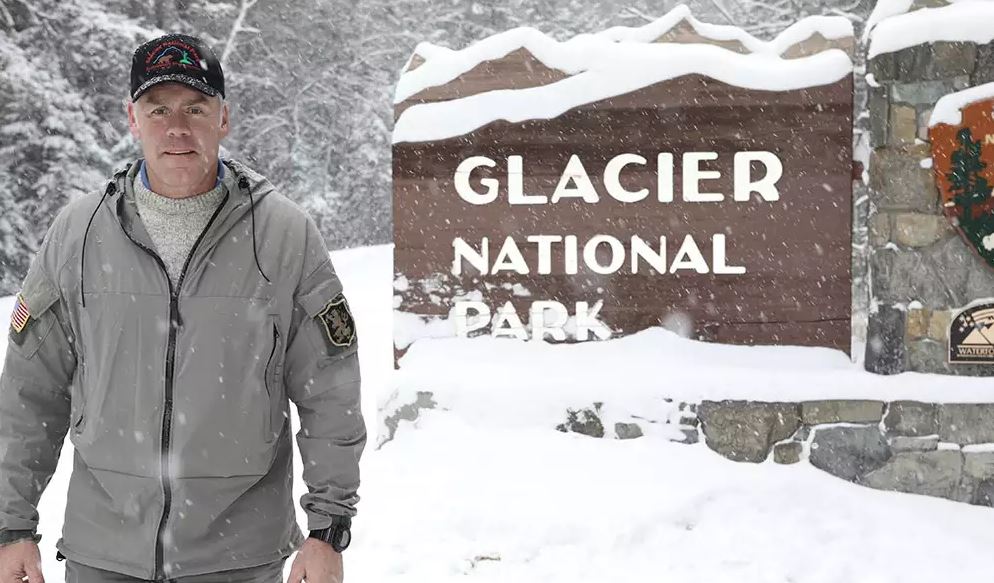
By FRANKIE BARNHILL • DEC 19, 2017
There’s a new push in Congress to allow mountain bikers access to wilderness areas.
Last week, a house committee approved a measure that would amend the Wilderness Act. The bill would allow mountain bikes in wilderness areas, setting up another legislative battle about shared use on public lands.
The Wilderness Act of 1964 has allowed the protection of millions of acres across the United States. Idaho has several areas within its borders, earning it the title of “the wilderness state.”
But to Craig Gehrke with the Wilderness Society, letting mountain bikers recreate in these areas could erode the purpose of the 53-year-old law.
“These are places we set aside for their primitive nature,” says Gehrke. “And for people to go in and experience them not in a mechanical way but basically on foot or on horseback, kind of a preservation of the first experiences pioneers had in these places.”
Gehrke points out that the law explicitly bars “mechanical transport.”
But some Idaho groups are cheering the bill. The Idaho Statesman reports the president of the Southwest Idaho Mountain Bike Association says the measure would bring younger mountain bikers into the conservation movement.
It’s not clear when the bill may come up for a vote on the House floor, but Gehrke says the Wilderness Society will lobby Congressman Mike Simpson to vote against it.
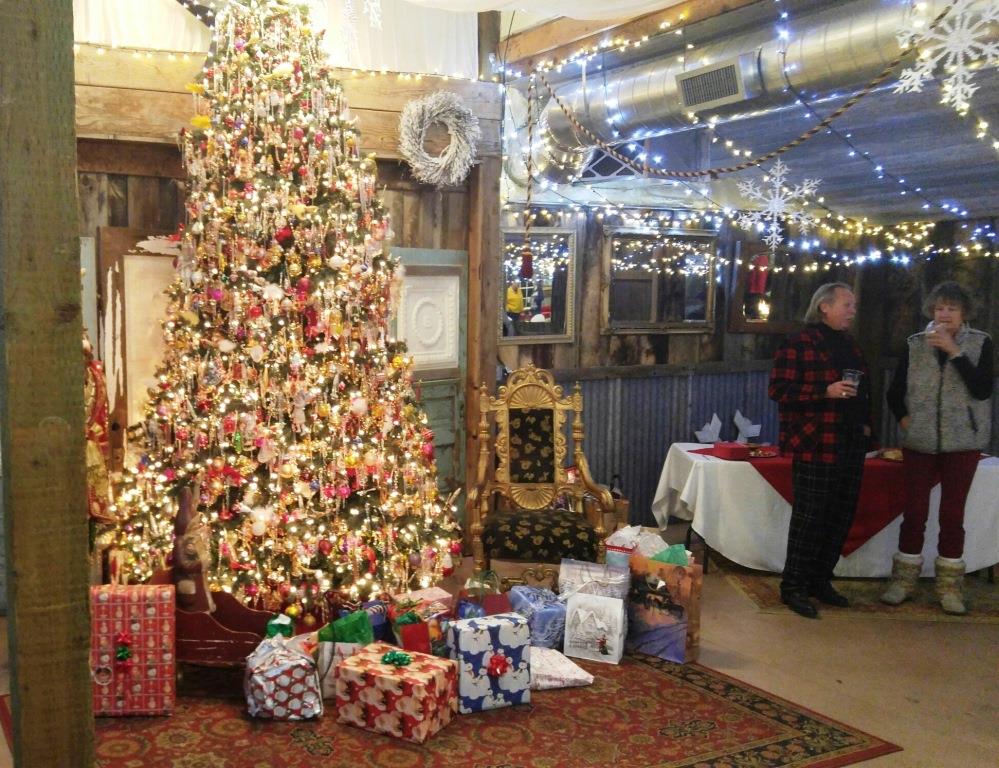 Saturday December 16, 2017 was a good day. Boise States football team came to play at their bowl game and made Oregon fans sit through a painful three hours. After the game, a number of members and guest enjoyed excellent company and great food. Thanks goes to Nancy Smith, Arlynn Hacker & Shannon Schantz for doing all the hard work getting the party organized.
Saturday December 16, 2017 was a good day. Boise States football team came to play at their bowl game and made Oregon fans sit through a painful three hours. After the game, a number of members and guest enjoyed excellent company and great food. Thanks goes to Nancy Smith, Arlynn Hacker & Shannon Schantz for doing all the hard work getting the party organized.
Charles and Lou Ann are checking out the fancy shoes Charles received in the gift exchange.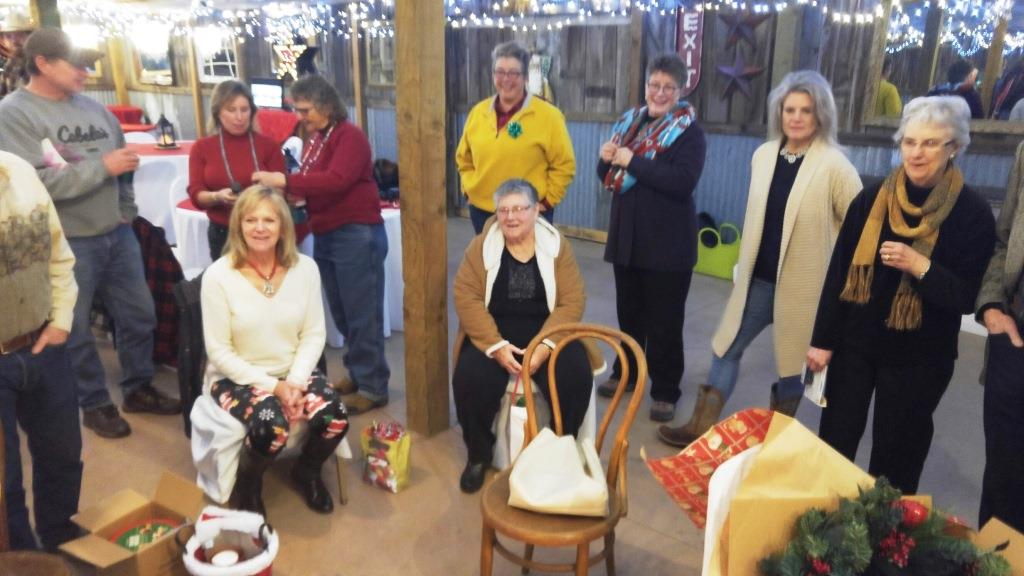
High Country Plastics primary goal is to provide safe and durable products for their customers and animals.
High Country Plastics takes great pride in keeping their product line creative and efficient to save customers time and money.
Our built-to-last products are known for their durability, quality, strength, innovation, warranty, FDA approval, safety, and satisfaction guaranteed – that’s the High Country Way.
For additional information, please visit our Contact Us page and let us know what we can help you with.
 |
Back | Next – Return to TOC |  |
In addition to the usual planning considerations, equestrian recreation trails and facilities require attention to the behavior and physical characteristics of horses and mules. The success of horse trails and recreation sites depends on how well planners and designers understand these animals.
Essentially, horses and their kin are prey animals. They developed behavior patterns and physical characteristics over millions of years spent in wide open spaces. Flight is their primary defense. They use their strength, stamina, agility, and speed to escape predators, notably large cats–such as cougars–and wild dogs–such as dingos. Horses and mules constantly monitor their surroundings and are always aware of available escape routes. They may become nervous when routes are narrow or blocked. Horses and mules also prefer to see what they hear or smell.
What frightens horses and mules is not always obvious. Anything that moves suddenly or makes an unexpected noise can rouse an animal’s survival instincts and prime it to bolt. This natural reaction–often referred to as a startle reflex–is the result of remarkably acute senses.
Horses and mules have excellent vision, hearing, and tactile senses. They are even capable of feeling vibrations through their hoofs, which often alert them to others long before the rider becomes aware. Horses and mules need a comfortable operating space. When they can see something suspicious from afar, they can more easily evaluate the danger and react accordingly. There is a fine line between what is comfortable for horses and mules and what seems dangerous.
In addition to confined spaces and predators, things that can startle a horse or mule include:

Figure 1-3–Anything that appears suddenly, makes an unexpected noise, or is unfamiliar engages a horse’s survival instincts. On the trail,
horses and mules are particularly wary of llamas, hikers with bulky backpacks, and bicycles.
So, what happens when horses and mules are startled? They have a range of responses, from remaining calm to becoming severely frightened. The more conditioned the animal is to uncomfortable situations, the more likely its response will be subdued. When something makes it nervous, an animal may dance around, inadvertently step on things, or balk. Horses or mules that are severely unnerved may run, jump, spin, or do a creative combination of all these things. When horses and mules feel the need to protect themselves, they may kick, bite, or strike. Experienced riders can hold a well-trained animal in check under most circumstances. There is a point, though, where a stimulus becomes so great that even the best conditioning will not override the animal’s innate fight-or-flight instincts.
Trail stock–especially mules–have highly developed memories for pleasure, pain, fear, people, and places. Many trail animals recognize a previously visited location or trail route (figure 1-4). Once a horse or mule has had a particularly unpleasant or painful experience, the animal will try to avoid that location, condition, or object forever. Recreationists in many areas minimize potential conflicts by practicing trail etiquette that favors needs of horses and mules. Chapter 12– Providing Signs and Public Information lists ways to communicate a trail animal’s needs to other trail users.

Figure 1-4–Horses and mules have excellent memories and can easily retrace routes they have traveled in the past. They avoid areas they associate with unpleasant experiences.
The goals of the SBFC Wilderness Ranger Intern (WRI) program are to train, educate, mentor and provide employment development opportunities for the next generations of wilderness professionals and provide skilled support to the Forest Service for accomplishing priority wilderness work.
This is a 14-week internship for military veterans and college students doing under-graduate or graduate work in conservation, resource management, wilderness, recreation or related fields. The internship offers 2 full weeks of wilderness skills training—crosscut saw use and certification, hand tool use, stock handling and packing, Leave No Trace and Wilderness First Responder training, followed by 12 weeks working in the Selway-Bitterroot and Frank Church Wilderness areas, with trained wilderness professionals, US Forest Service managers and volunteers.
The WRI will also learn about the Wilderness Act and how it established an overarching framework for wilderness stewardship, what wilderness character is and how to conduct wilderness character monitoring.
In 2018, WRIs will receive an AmeriCorps award.
The application will close on February 16, 2018 at 5pm MST. Apply Now!
Your help needed to ensure that BCH States submit testimony on H.R. 1349. Deadline: No later than noon, Eastern time,Dec. 7th.
Dear BCHA National Board Member,
I seek your help in following through with BCH state presidents to make sure they are able to submit testimony prior to the Dec. 7th congressional hearing on H.R. 1349 (bikes in Wilderness) conducted by the Federal Lands Subcommittee.
As you will see below in an email sent yesterday, state presidents have been provided a template on which to base their state letters. They have been asked to submit their testimony, on BCH state letterhead, via email to brandon.bragato@mail.house.gov. Brandon’s email is for submitting organizational testimony only (i.e., from BCH state or chapter representatives) and is not to be used for individual or personal letters or testimony.
Can you please act to ensure that this important task has been accomplished? And could you please forward to me a copy of the testimony submitted by your state for our records? We will need these letters to use with members of Congress if H.R. 1349 continues to move forward.
Thank you!
________________________________________
December 5, 2017
To: State Presidents and Chairmen
BCH State and Chapter Testimony Needed by Dec. 6, Close-of-Business, to U.S. House of Representatives, Subcommittee on Federal Lands
Dear BCH state and chapter presidents,
This is an updated alert containing a specific email address for sending BCHstate and chapter comment letters(i.e., testimony, not individual letters) prior to theDec. 7 thhearing.
A full template on which to base your state and chapter letter can be found here. HR_1349_TWS_BCHA_Testimony
In addition to any letter you’ve already submitted to your member of Congress, please send a copy of your state and chapter letter using the template to House Subcommittee on Federal Lands professional staff person, Brandon Bragato at brandon.bragato@mail.house.gov.
Please email to Brandon only testimony from your BCH state or chapter.
Include your state/chapter logo at the top of your testimony.
The House Natural Resources Federal Lands Subcommittee will hold a hearingDec. 7 thin Washington, DC, on H.R. 1349. The bill represents an unprecedented assault on the 1964 Wilderness Act, wilderness areas across the country, and poses a significant danger to users of pack and saddle stock.
This issue is among the highest priorities for BCHA. Please email Brandon with your state or chapter’s testimony today!
Freddy Dunn
BCHA National Chairman
 Two bipartisan bills show how the left and the right can converge on public land policy
Two bipartisan bills show how the left and the right can converge on public land policy
Outside Magazine – Jake Bullinger
It would seem Republicans and Democrats are wholly divided on public land policy. During the 2016 campaign, the GOP platform called on Congress to “immediately pass universal legislation” to “convey certain federally controlled public lands to states,” while Democrats sought “policies and investments that will keep America’s public lands public” by prioritizing access and environmental safeguards.
But, believe it or not, some consensus exists. A pair of bills introduced this year—including one that would make it easier to transfer federal land to states—shows that Republicans and Democrats can actually agree on certain aspects of public land management.
The land transfer bill, dubbed the Advancing Conservation and Education Act, was introduced on November 6 in the House by Chris Stewart, a Utah Republican, and Jared Polis, a Colorado Democrat. An identical measure in the Senate is backed by Democrat Martin Heinrich of New Mexico and Arizona Republican Jeff Flake. The bill would allow western states to ask the Department of the Interior to swap state-held trust lands surrounded by federal conservation plots for federal parcels that are easier to develop.
Here’s the issue: Western land is divvied up into a grid of state, tribal, federal, and private ownership. Occasionally state trust lands, which are designated to generate revenue for public schools, are surrounded by national parks, national monuments, or wilderness areas. Consider Arizona’s Petrified Forest National Park. Peppered throughout the park is trust land deeded to Arizona for the purpose of generating money for schools. Arizona has the legal authority to lease those parcels, but running cattle or setting up a pump jack on a 160-acre plot surrounded by stringent national park regulations would be impractical for any rancher or driller. It’s a lose-lose for the state and the feds: Arizona is unable to tap into those dollars, and the national park lacks consistent management within its borders. READ MORE
 BY CYNTHIA SEWELL
BY CYNTHIA SEWELL
DECEMBER 02, 2017
Three of the contenders to become Idaho’s next governor shared remarkably similar views Saturday on wildlife conservation, fishing, hunting and access to public lands.
In questions posed at a forum at Boise State University, Democrat A.J. Balukoff and Republicans Tommy Ahlquist and Brad Little differed mainly on the handling of the state’s sage grouse management plan, and over the idea of breaching four Snake River dams in Washington state to recover endangered salmon and steelhead populations.
Ahlquist Clarifies Breaching Dams Stance After Forum (Dec 15, 2017)
The forum was sponsored by the Idaho Wildlife Federation and 17 other sportsmen and wildlife groups. Each candidate spoke separately for about 30 minutes to a crowd of about 100 people clad in flannel, jeans and camo.
The three have quite different backgrounds: Little, a native Idahoan, is a longtime politician and rancher who currently serves as Idaho’s lieutenant governor. Ahlquist is a doctor, developer and political newcomer best known for recent Boise projects such as the Eighth & Main building. Balukoff is a CPA, businessman and longtime trustee on the Boise school board who ran unsuccessfully against Gov. Butch Otter in 2014.
Absent among the leading candidates was Republican Congressman Raul Labrador, who declined to participate. That garnered a chorus of hisses and boos from the audience.
“We do have a spot reserved for him right up front in case he shows up,” said Brian Brooks, Idaho Wildlife Foundation executive director. “So, if you see him, would you please direct him to his empty seat.”
Some topics that each of the three addressed:
Hunting and fishing: All three said they are outdoorsmen and hold Idaho hunting and fishing licenses. Ahlquist talked about fishing last week with his father-in-law. Balukoff discussed getting his annual wild turkey and a recent failed antelope hunt. Little recounted how for four generations, his family has held an annual upland bird hunt.
Public lands: The candidates said they are not in favor of the state taking ownership of federal land in Idaho, mainly because it would be too cost-prohibitive. But they do want the state to have more of a role in how federal land is managed, and better public access to federal lands.
“Thirty-three million acres is a lot of land,” said Balukoff. “There is enough space to meet needs. If we want wild and scenic areas that are primitive … (or) areas we can designate for use of ATVs – there is room to do multiple uses on our public lands.”
Salmon and steelhead recovery: All agree the federal plan in play for the last 25 years is failing.
“Our rural communities need this industry,” Ahlquist said. “We need to figure this out. … We need to protect Idaho’s interests, Idaho industries, Idaho fish.”
Wildlife management: Political leaders need to listen to professional wildlife managers and biologists. And, all three said, the Idaho Fish and Game Commission should not be politicized.
Endangered species: The candidates said we should follow the advice of biologists and wildlife managers to ensure that Idaho keeps sustainable populations to avoid federal intervention.
The candidates did have a few differences on issues.
Breaching Snake River dams: Ahlquist and Balukoff said they would consider it as a possibility. Little said he would not, but he would consider looking at how that water is managed, including adjusting flows or releasing more water over spillways instead of through turbines.
Sage grouse: All agree that any management plan needs to be collaborative. Ahlquist and Balukoff do not support Idaho’s efforts to fight an Obama-era grouse management plan in court. Little said such an action sometimes is necessary if the federal government does not uphold its end of the deal.
The entire 90-minute forum can be viewed on the Idaho Wildlife Federation’s Facebook page.
Emily Benson Nov. 27, 2017
How much is hunting and fishing access to 3.4 million acres of land in Utah worth? Last year, the answer was $776,000. That was the amount the Utah Department of Natural Resources paid another state agency, the School and Institutional Trust Lands Administration (SITLA), to secure public access to state trust lands, granted to Western states by the federal government to generate money for schools and other public institutions.
This fall, however, the deal between the Natural Resources Department and SITLA expired. In negotiating its renewal, SITLA wanted to raise its fee to market rates, estimated at $1.8 to $3.9 million a year for the 1 million acres that have commercial hunting value. If the department didn’t pay up, SITLA seemed ready to lease exclusive access to beloved places like the Book Cliffs — a vast wilderness of rugged bluffs and forested valleys teeming with elk, mule deer and cutthroat trout — to wealthy hunters. Access to prime areas would be scooped up mainly by customers willing to pay thousands of dollars for a single hunt, with only a handful of permits issued through a public lottery.
Kim Christy, SITLA’s deputy director, argued that the agency was merely fulfilling its obligation under the state Constitution to optimize revenue. But many sportsmen saw it differently. Bill Christensen of the Rocky Mountain Elk Foundation says access to state lands shouldn’t be reserved for the highest bidders. And SITLA’s demands underscored his fears about what could happen should federal lands be transferred to state control: privatization and loss of access. “I have been very concerned about how greedy SITLA has been in recent years,” Christensen says.
State trust lands are owned by public entities, but they aren’t “public” the way federal lands are. Most states don’t have to manage them for multiple uses, so there’s no guarantee of public access for hunting, hiking and camping. Instead, these lands are managed to make money, traditionally by leasing them for grazing, mining, timber or energy development. Sometimes the land is sold outright.
“The mandate that states have is often interpreted as this really rigid thing,” says Shawn Regan, a research fellow at the Property and Environment Research Center, a Montana-based free-market think tank. But hunting, especially, can be a source of revenue for state trusts. “There are ways to allow access or provide conservation benefits while still meeting the requirement to benefit the trust.”
Public access to trust lands varies widely from state to state. Idaho and Wyoming allow free access, while New Mexico and Colorado have interagency payment schemes similar to Utah’s. Still, access is provided primarily at the discretion of state agencies, leaving the public with little say in whether certain parcels are put up for sale, threatened with development or closed to the public. Read More

With a career dedicated to undermining public lands and public servants, Budd-Falen is uniquely unqualified for the director’s post
Budd-Falen is uniquely unqualified to oversee the BLM, a department charged with managing 258 million acres of America’s public lands — and nearly 700 million acres of oil, gas, and other minerals — on behalf of the American public. She has spent her career fighting against the very existence of U.S. public lands, filing frivolous lawsuits against the BLM, working to subvert public land managers, supporting unpopular efforts to dispose of public lands, and even aligning herself with fringe extremists.
Here are three important reasons Interior Secretary Ryan Zinke and the Trump administration should look elsewhere rather than nominate Budd-Falen to run one of America’s most important agencies. Read More
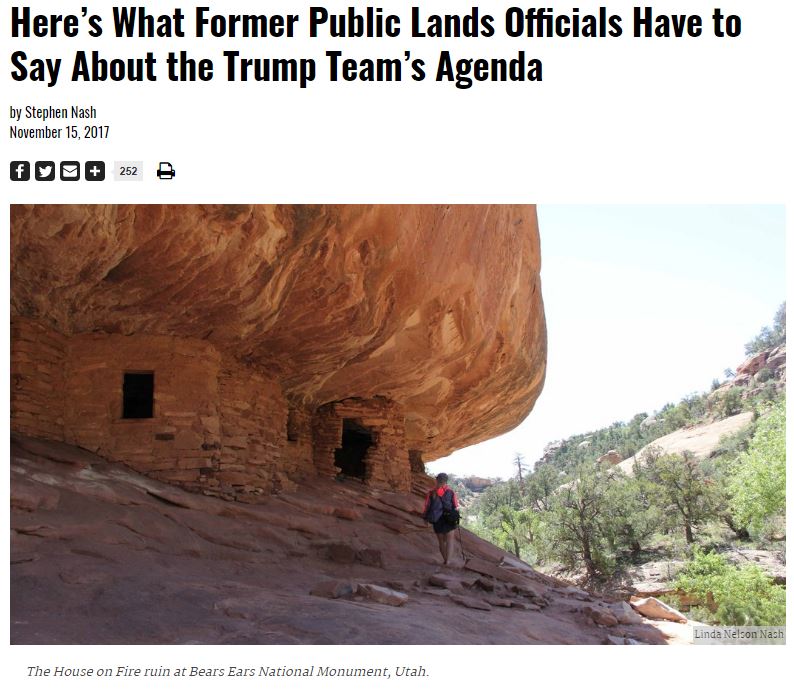 Many visitors to U.S. national parks and monuments—a record 331 million in 2016—seek a hiatus, however fleeting, from the daily grind. But increasingly, they may find themselves face-to-face with some of the things they are trying to escape.
Many visitors to U.S. national parks and monuments—a record 331 million in 2016—seek a hiatus, however fleeting, from the daily grind. But increasingly, they may find themselves face-to-face with some of the things they are trying to escape.
The Trump Administration’s quick-step public lands agenda for 2017 includes budget cuts, expanded resource extraction (mining, logging, drilling, and grazing), shrinking national monument boundaries, and a relaxation of restrictions on problematic activities like the use of plastic bottles.
At Dinosaur National Monument, for example, the Bureau of Land Management plans to auction public land for oil and gas drilling. The drilling site is near the park’s entrance road and will be visible from the visitor center. The BLM says it will take steps to minimize the impact, including light shields, noise mufflers, and “placement of exhaust systems to direct noise away from noise sensitive areas” and “avoiding unnecessary flaring of gas.”
But Mike Murray, who worked as a national park administrator and ranger at Dinosaur National Monument for thirty-four years, calls the decision to auction drilling rights there “indefensible.” The monument’s pitch-black night skies and silent soundscapes have been protected by the Park Service since Woodrow Wilson’s presidency, Murray says in an interview. Visitors, he notes, will now witness “oil rigs instead of a pristine landscape.” And the Trump team’s “total priority” on mining and drilling threatens other values, like “protecting parks for future generations and for wildlife.” Read More
Last month, the Center for Western Priorities, a Denver, Colorado–based nonprofit, published a comprehensive report that compared state public lands policy across the Mountain West. Eight states—Montana, Idaho, Wyoming, Nevada, Utah, Colorado, Arizona, and New Mexico—were scored. The results were also discussed on the organization’s podcast, Go West, Young Podcast.
The Trump administration’s hostility to public lands was part of the impetus for the report, the authors told Outside. Wary of focusing its mission solely on federal accountability, Western Priorities also wanted to examine what states could do on their own. But understanding state policy when it comes public lands is challenging; unlike federal law, tracking state-level regulation gets messy.
“We try to be a data-driven organization,” says Aaron Weiss, media director at Western Priorities, “and that tends to be fairly easy on the national level, because, at least up until now, DOI and Forest Service were good about collecting and disseminating data.” If you couldn’t figure something out, “you could usually call up someone at the Park Service or at BLM and figure out how to get that data. It’s much harder to do at the state level.”
That’s because the way states regulate their local public lands varies widely. “What counts as a spill in one state doesn’t count in another,” Weiss says. In that light, Western Priorities set out to research and compare state policies “apples to apples.” The project, led by Western Priorities’ Sara Rose Tannenbaum, took about eight months to research and involved somewhere between 80 and 100 interviews with policymakers and related experts. Western Priorities chose to score states in three categories: lands and access, outdoor recreation, and responsible energy use. Montana and Colorado received the highest overall grades, but there was still a good deal of divergence within each category.
The results look at what states are doing well when it comes to public lands protections, as well as how they can improve and adopt best practices from one another. (Charted above are the states’ total scores from all three categories, with the highest possible score being 33.)
“This can be a useful tool to people as they’re trying to aid their state in improving, or branching out, or being innovative,” Tannenbaum says. “States really have a lot to learn from one another. It’s important to celebrate what’s worth celebrating in your state and also identify moments for improvement.”
We broke down how the states did in each category and why.
Western Priorities looked at hiking, hunting, fishing, and camping access on state public lands using a few different parameters. States can do a variety of things with their land trusts—sell, lease, or neither—and access often changes based on those designations. Additionally, local public lands can’t always be accessed in some states if they’re surrounded by private property, and the commitment to funding for public lands can be inconsistent.
Stream access is highly variable as well. Montana and Idaho, for example, allow people to float, wade, and walk along streams up to the high-water level, even when rivers cross private lands. Montana has enshrined public access to rivers in its constitution, an issue that has caused trouble even for Greg Gianforte, the state’s recently elected congressman. But other states, like Colorado, are more restrictive, and enforcement and culture varies. In Utah and New Mexico, the report notes, there have been “issues of private land owners erecting barbed-wire fences through streams and putting up ‘no trespassing’ signs.”
Weiss is careful to add that states weren’t given negative points, which can obscure regressive trends. “On lands and access, the big takeaway is that this is still a very active fight in a lot of states,” Weiss says, mentioning the Wilks brothers threatening ranchers’ water rights in Montana and alarming initiatives led by Utah officials to sell off public lands for resource extraction.
Colorado ran away in this category, while states like Arizona and Wyoming struggled. Infrastructure for public access was a key part of the equation, as was having dedicated offices in state governments devoted to the cause. (Colorado was the only state to receive top marks on both fronts.) Western Priorities also believes there’s plenty of room for improvement when it comes to promoting outdoor and environmental education, a category in which no state received top two scores. But most important, commitment to public lands and recreation is most clearly reflected by one thing: consistent, dedicated money.
“It’s really wonderful that a lot of states have passed a Public Lands Day,” Tannenbaum says, “And we’re really supportive of that—Colorado’s Public Lands Day was a hit this year. But that really has to be backed by concrete action.” Groups like Great Outdoors Colorado do a great job of addressing all sorts of outdoor recreational priorities, she told me, but not all states put real money behind such agencies.
“This topic, you could write an entire report on it,” Tannenbaum says. “So we focused on concrete protections for air, water, and wildlife as opposed to alternate uses.” One of those uses they had to leave out, they say, was the potential for development of renewables on public lands.
Instead they examined, among other issues, how far back oil wells could be set from houses, transparency surrounding chemicals used in fracking and spills, mine bonding, and methane emissions. One crucial aspect was the return on investment taxpayers receive from taxing energy industries that exploit public lands. That came down to looking at the kinds of taxes and royalty rates states require the extractive industry to pay, which can be used to maintain and protect public lands. Colorado once again did especially well, with royalty rates above the federal rate, while also requiring public reporting and disclosure of fracking chemicals 48 hours prior to use (Colorado, Idaho, Nevada, and Utah all use FracFocus to do this). Arizona scored poorly on both these fronts.
Weiss and Tannenbaum emphasize that public engagement is critical in keeping outdoor recreation and access to state trust lands a vibrant part of the West. “Number one is to know who your state legislators are and keep them on speed dial,” Weiss says. “Go to their coffees, go to their town halls before the [legislative] session starts, so they know what’s important to you, both in terms of good bills and what a bad bill would look like.”
Join our editors for a Q&A with Weiss and Tannenbaum on Monday, November 13, at 2pm M.T. in the Outside Public Lands Forum on Facebook.
The federal government agency responsible to safeguard over 20 percent of America’s public lands, waters, and wildlife has been hijacked. And it’s an inside job.
The agency is the Interior Department, and the hijacker is the Secretary himself, Ryan Zinke. Zinke often invokes the image of a modern day Teddy Roosevelt, but TR would be appalled by the polluter-driven, anti-conservation agenda Zinke is dictating.
If there were any doubts about Zinke’s intent, they were put to rest with the release of his Final Report: Review of the Department of the Interior Actions that Potentially Burden Domestic Energy in late October.

The potential impact if Zinke’s agenda is realized:
The Zinke agenda is plain: it’s pro-pollution and against the public interest the Interior Department is supposed to protect. The Interior Department is entrusted to manage America’s natural resources and cultural heritage; provide scientific and other information about those resources; and honor its responsibilities to American Indians, Alaska Natives, and affiliated island communities.
But under Zinke, the Interior Department has turned into a leasing agency for the fossil fuel industry. Zinke has stacked his staff with former dirty energy industry lobbyists, and made it his mission to promote fossil fuels—not to preserve public lands or waters, or promote low-impact clean energy, like solar energy, on public lands.
The Zinke agenda isn’t even good business for American taxpayers. The fossil fuel giveaway will short-change taxpayers, states and local economies tens of millions of dollars annually.
And finally, the Zinke agenda is anything but a responsible energy plan for America. You’ll find plenty of polluting, 19th century ideas in Zinke’s plan, but you’ll find few forward-looking clean energy solutions. READ MORE
Plan to Attend this event – Make your views on Public Lands in Idaho known!

To accomadate the recently scheduled BSU home game, we have moved the Sportsman Forum to 2:30pm of the same day, Dec. 2nd. The location is still the Special Events Centerin Boise State University’s Student Union Building.
Click this Facebook Event Page link to let us know you’re “going” and follow news on the event.
Idaho Wildlife Federation Hosts Sportsman Gubernatorial Candidate Forum
Contact: Brian Brooks, Idaho Wildlife Federation Executive Director (208.870.7967)
BOISE- The Idaho Wildlife Federation and 17 affiliated sportsman and wildlife groups across the state are hosting a Sportsman Gubernatorial Candidate Forum December 2nd at the Special Event Center in the Student Union Building at Boise State University. . The venue accommodates several hundred attendees and free on-campus parking is provided.
Candidates will weigh in on natural resource topics important to over 400,000 hunting and fishing license holders in the state ranging from public lands access, public fish and wildlife management and hunter/angler retention.
Brian Brooks, executive director of the Idaho Wildlife Federation, says the Forum is an informative tool for sportsmen heading to the ballot box. “This is an opportunity for the folks vying for Idaho’s top leadership position to communicate to Idaho sportsmen and women their opinions, strategies, and solutions addressing the complex issues facing Idaho’s wildlife, public lands, and massive outdoor recreation industry.”
Gubernatorial candidates received invitations to the Sportsman Forum on September 15th with a range of available dates.
“We appreciate that the candidates for Governor have agreed to come down and talk to sportsmen,” said Michael Gibson, Idaho Field Coordinator for Trout Unlimited. “Idahoans share a passion for the outdoors and the hunting and fishing opportunities it provides. I think they want to be sure their future Governor shares that passion, or at the very least, understand it.”
The forum will be moderated by Eric Barker, outdoor editor for the Lewiston Tribune.
The event is free for the public and a reception is planned in the Hatch Room of the Student Union building just after the forum concludes.
To follow updates for the event and add it to your calendar, click this link to the Facebook event or sign up for our email network for free.
Raul Labrador – Public Lands Position
Idaho Representative Raul Labrador voted to continue using tax dollars to explore ways to transfer public lands straight to private ownership, contradicting own claims.
WASHINGTON D.C. – On September 13, 2017 Idaho Representative Raul Labrador voted on a bill amendment that gave us a glimpse of truth regarding his views on public lands. Considering he has told Idahoans that he does not want to see public lands sold off, it was a move that left those who value public lands and wise use of tax dollars feeling deceived, even among his own supporters. In four short steps we will walk you through the content and context of the vote.
BACKGROUND:
For some time the Representative has boasted that he believes our national public lands should be transferred to state ownership. This worries many people because states are constitutionally obligated to maximize profits from such lands, which results in singular management directives and often their sale (Idaho has sold 41% in just over 100 years). Though the state of Idaho has violated its own constitution over 300 times selling lands illegally, fears of a public lands transfer are further bolstered by several economic studies illustrating that states would need to increase land sales to pay for newly incurred management costs like fire fighting, noxious weeds management, watershed health, and so on. In fact, a nonpartisan study found the state of Idaho would lose money in eight of nine scenarios if public lands were transferred. So, rightfully Idaho sportsmen and other public lands users have relentlessly expressed opposition of the transfer, sale, or privatization of our public lands.
PAST PROCLAMATION:
Regardless, Representative Labrador defends his platform mentioning he doesn’t want our public lands sold to private ownership, though he has offered no solution to prevent such sales if public lands were transferred. Here is a video of the Representative telling our executive director that he has been wrongfully accused of wanting to sell public lands into private ownership. And here is an article where the Representative states, “a group of people are saying we want to sell off our federal lands and there is no truth to that at all.”
CONTRADICTION:
This September, Amendment 371 was introduced on the House floor. The Amendment would have prohibited the use of public funds to pursue ways to transfer federal lands to private owners. Voting for Amendment 371 would be the perfect way for Rep. Labrador to verify his claims that “a group of people are saying we want to sell off our federal lands and there is no truth to that at all.” He voted against it, directly contradicting his own claims. That’s right- Rep. Labrador voted down the amendment, approving the use of public funds to find ways to sell public lands to private owners.
REVELATION:
If you feel misled, or deceived, that is understandable. The threat of losing hunt-able and fish-able acreage does not sit well with Idahoans. What’s worse is being told by a politician that the threat doesn’t exist, while he actively votes to make the threat a reality.
Some people call this – this saying one thing and doing another – lying. Us sportsmen might embellish a fish story or two, but we don’t like outright lying. Honesty is the mark of good character, a good lesson to learn for folks who represent us.
Representative Mike Simpson voted in favor of Amendment 371.
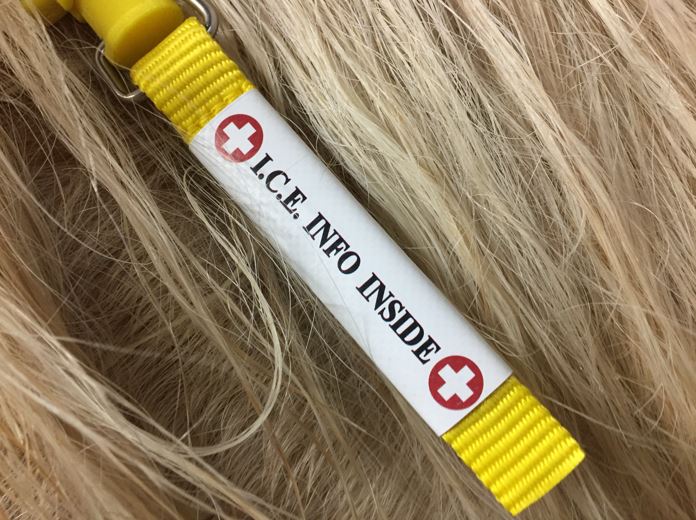 I teach Emergency Preparedness for horse and mule riders at equine events across the country and it’s amazing how many people don’t think about equine identification.Fortunately, Sierra View Ranch has thought about the topic. A lot. Their line of “In Case of Emergency” or I.C.E. products (including the I.C.E. Halter, I.C.E. Clip-on tag. I.C.E. UltraLite, and the ManeStay) has been created with one goal in mind. To help reunite you and your animal in case a ride becomes “eventful”.
I teach Emergency Preparedness for horse and mule riders at equine events across the country and it’s amazing how many people don’t think about equine identification.Fortunately, Sierra View Ranch has thought about the topic. A lot. Their line of “In Case of Emergency” or I.C.E. products (including the I.C.E. Halter, I.C.E. Clip-on tag. I.C.E. UltraLite, and the ManeStay) has been created with one goal in mind. To help reunite you and your animal in case a ride becomes “eventful”.
The beauty of all I.C.E. products is in the highly visible “I.C.E. INFO INSIDE” tag that opens to reveal info on the animal. These ingenious horse labels are a fabulous way to keep your contact information on your animal in case the two of you become separated.
You can learn more about these products at the Sierra View Ranch General Store http://www.sierraviewranchgeneralstore.com.